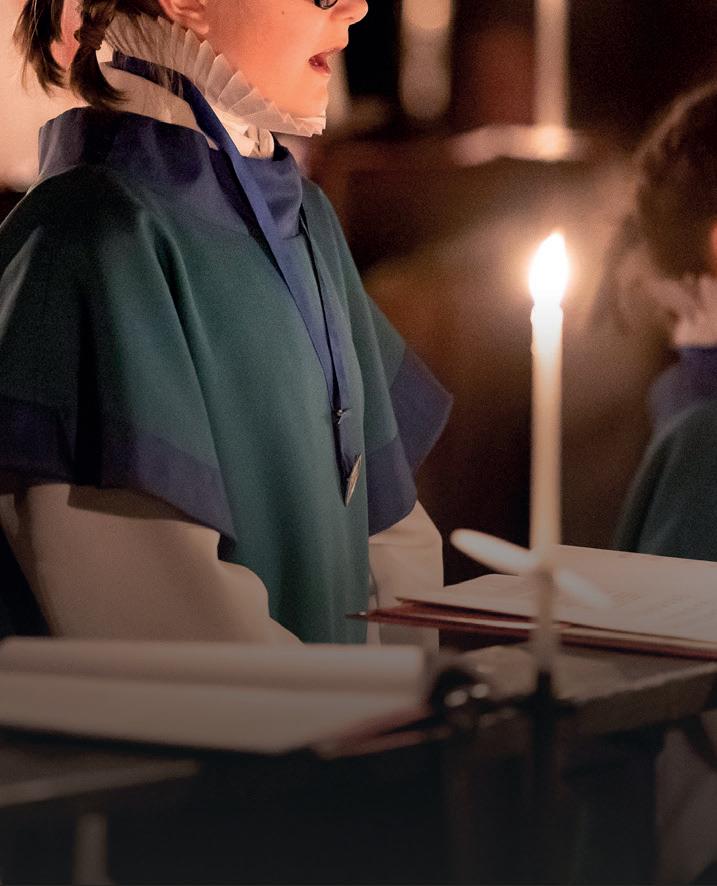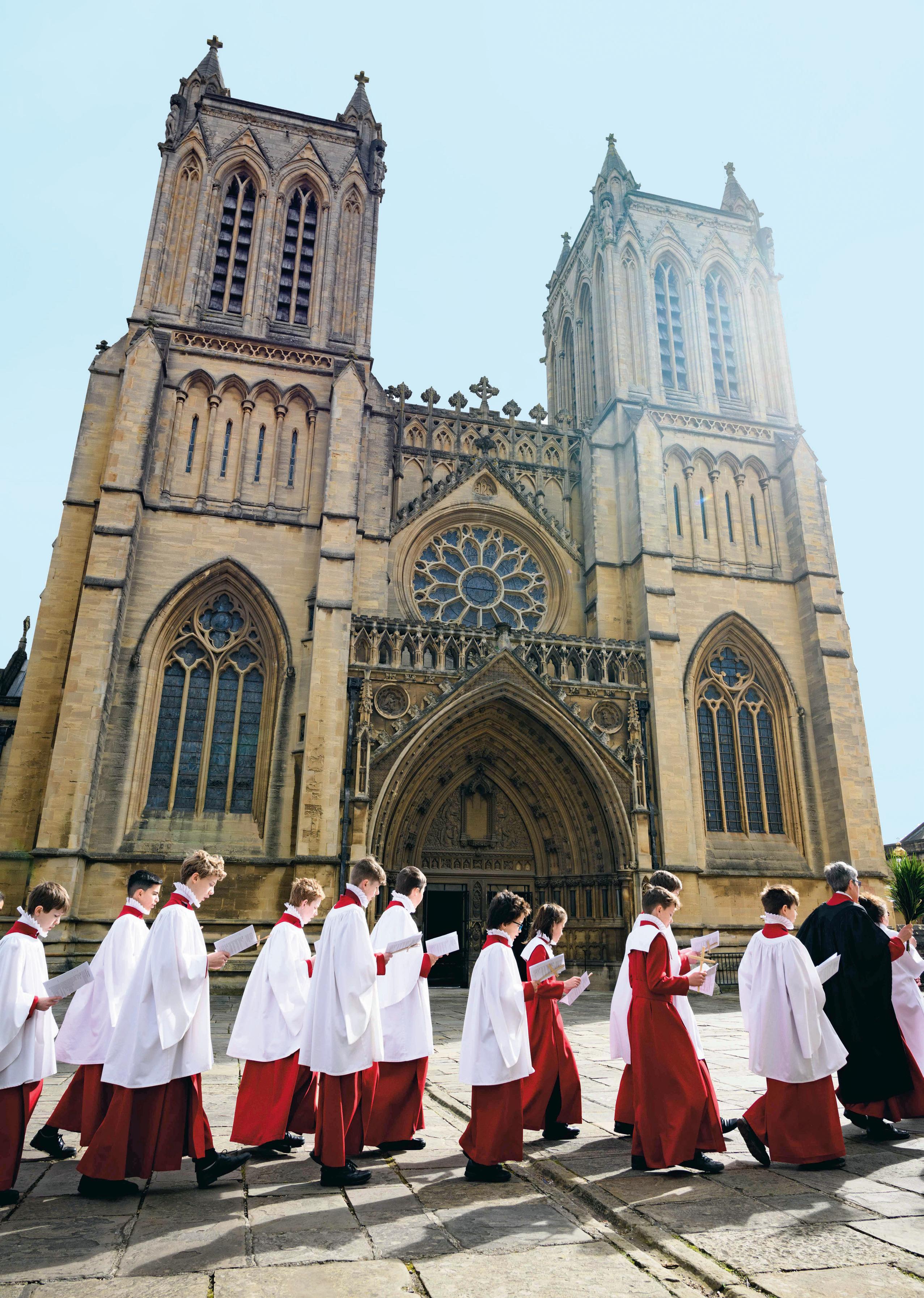










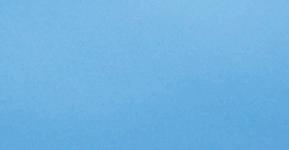
How guest ensembles contribute to liturgical life out of term time





The innovative WOOFYT is opening up the instrument to young ears

INSIDE THE ORGAN PALESTRINA AT 500
The composer’s influence on choral music across the centuries CHOIR SCHOOLS

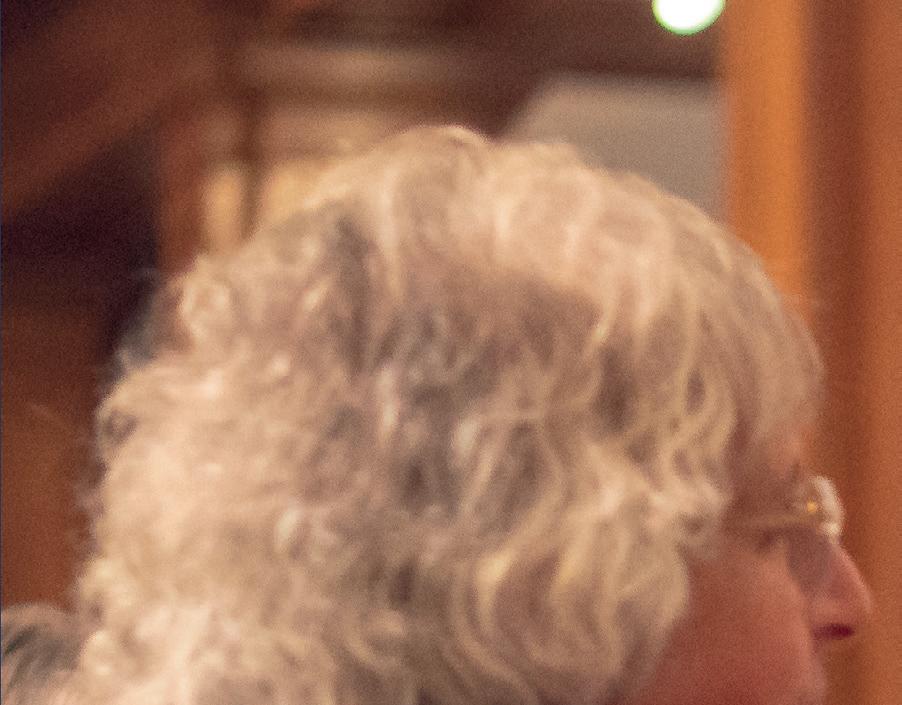










Royal Patron
HRH The Duchess of Gloucester
President
Harry Christophers CBE
Ambassadors
Alexander Armstrong, Anna Lapwood MBE Board of Trustees
Jonathan Macdonald (Chair), James Gurling OBE, David Hill MBE, Sue Hind Woodward, Stuart Laing, James Lancelot, Giverny McAndry, Heather Morgan, James Mustard, Isobel Pinder, Gavin Ralston, Simon Toyne CEO
Jonathan Mayes
Programmes Director
Cathryn Dew
Programmes Manager
Anna Elliss
Development Director
Victoria McDougall (maternity cover)
Development Officer
Katy Ashman
Volunteer & Events Coordinator
Hannah Capstick
Digital & Communications Manager
Anna Kent
Director of Finance & Resources
Jessica Lock
Finance Officer
Amanda Welsh
Cathedral Music Trust is extremely grateful to our team of volunteers across the UK who give many hours of their time each year to support the work we do.
Cathedral Music Trust 27 Old Gloucester Street London WC1N 3AX info@cathedralmusictrust.org.uk 020 3151 6096 (office hours) www.cathedralmusictrust.org.uk
Registered Charity Number 1187769
Facebook CathedralMusicTrust X @_cathedralmusic
Instagram @cathedralmusictrust
YouTube CathedralMusicTrust
Linked In Cathedral Music Trust
CATHEDRAL MUSIC MAGAZINE
Interim Editor Hattie Butterworth editor@cathedralmusictrust.org.uk
Designer Jo Craig
Production Manager Kyri Apostolou
Cathedral Music is published for Cathedral Music Trust by Mark Allen Group twice a year, in May and November. Spring 2025
am writing the welcome to this issue of Cathedral Music sitting in the crypt of St Martin-in-the-Fields church, in the heart of London. Having dropped off my daughter for her rehearsal with the junior choir here, I’m afforded some time to reflect on how music, and the places where we make music, bring people together and help create cohesion. It is brilliant to see in action, as my relatively shy 8-year-old comes to life, launching into joyful song with her fellow choristers.
That is the type of encounter I have been privileged to witness on many occasions over my first 9 months at the Trust; seeing firsthand the impact of cathedral music in many places across the UK. It is also a theme that is reflected across articles in this issue of the magazine as we explore the brilliant training afforded to so many choristers in choir schools across the country (‘Tradition and Change’ p.28), the joy and enthusiasm of visiting choirs undertaking tours and residencies (‘Sacred Soundscapes’, p 39) and the unique challenges composers face when writing for young voices (‘The Brilliance of Youth’ p 46).
It was a particular pleasure to see interviews with some friends I used to sing with at Calvary Church in Pittsburgh, as they travelled to Lincoln Cathedral for a week last summer. Their opportunity to experience the daily routine of services – at a place whose roots trace back to the beginnings of the cathedral music tradition – reminds me what a unique and precious jewel we are custodians of. It is no wonder that there is such strong international admiration for this music and, despite the many challenges we know exist, it is heartening to see the joy with which the next generation plays its part.
As my daughter emerges from the rehearsal room laughing and chattering, I can’t help but feel optimistic about the future, and the role that we all get to play in helping cathedral music to thrive.
Jonathan Mayes, CEO, Cathedral Music Trust
The views expressed in articles are those of the contributor and do not necessarily represent any official policy of Cathedral Music Trust.
Advertisements are printed in good faith, and their inclusion does not imply endorsement by the Trust; all communications regarding advertising should be addressed to info@cathedralmusictrust.org.uk.
Every effort has been made to determine copyright on illustrations used; we apologise for any mistakes we have made. The Editor will be glad to correct any omissions.
Corrections from Cathedral Music, Autumn 2024: p.9. Kate Aitken, Head of Voice at St Mary’s Music School, was misquoted, with ‘changing’ voices incorrectly referred to as ‘breaking’ voices. The article also incorrectly referred to St. Mary’s Music School as ‘St Mary’s School’; p.41. Mr Nigel McClintock resigned from his post at Saint Peter’s Cathedral, Belfast in 2019, not in 2022 as originally stated. Please accept our apologies, on behalf on Mark Allen Group, for these errors.
Front cover: Lincoln Cathedral (Photo: Adobe Stock) Back cover: Bristol Cathedral (Photo: Jon Craig)

28 The future of choir schools
Robert Guthrie explores the wide-ranging models for educational establishments connected with choral foundations and the challenges they face


36 The Woofyt
An innovative approach to helping children understand the intricacies of the organ through interactive workshops
39 Visiting choirs
Ensembles from abroad play a crucial role in British liturgical life throughout the holidays –Clare Stevens meets some of them 31 Summer Festivals
Our comprehensive guide to concerts and events taking place in churches and cathedrals throughout the coming months

42 Palestrina at 150

As the music world marks the anniversary of the Italian composer’s birth, Edward Breen explores his influence on choral music today

46 Music for childrens’ choirs
Composer Will Todd explains how he writes music for young voices, and the transformative impact the best of the genre can have
3
Cathedral Music Trust’s CEO welcomes you to this new issue
6
The latest developments and stories from across the world of church and cathedral music
19
Who is moving, and to where? We congratulate those taking on exciting new roles
21
Join Cathedral Music Trust at a gathering near you
The organisations which have benefi ted from the Trust’s vital support
Recent releases of choral and organ music reviewed, plus a round-up of the latest scores, and a new novel
66
Cathedral Music Trust volunteer Jean Duerden on the joys of supporting both the organisation and her local cathedral in Blackburn

Anna Lapwood, Director of Music at Pembroke College Cambridge and Cathedral Music Trust Ambassador, has announced that she is to leave her post at the Cambridge college at the end of the academic year. When appointed in 2016 at the age of 21, Lapwood became the youngest person to hold the position of director of music at an Oxford or Cambridge university college, and now leaves to pursue her solo organ career. Since her appointment at Pembroke, Lapwood has developed a significant online following with over
one million TikTok followers, becoming known by many as the ‘TikTok organist’ and opening up the world of the organ to a younger audience. Lapwood is also now an associate artist at the Royal Albert Hall and has sold out her live concert at the hall on 15 May.
In a statement on Instagram, Lapwood said: ‘Some rather big news to share. At the end of this Academic year I’m going to be leaving my job at Pembroke so that I can pursue organ playing full-time. This is, without a doubt, one of the hardest decisions I’ve ever made, and I can’t describe
how much I’m going to miss the wonderful musicians in the Chapel Choir and Girls’ Choir ... I can’t wait to see what they will achieve, and I will be cheering them on from my organ bench.’
Lord Smith, Master of Pembroke, said: ‘Anna has transformed Pembroke’s music and choirs ... she has brought the power of music to make a difference to communities and schools across Zambia; and she has given a real lift to the entire College in the process.’
Luke Fitzgerald will replace Lapwood at Pembroke later this year.
The Cathedral Music Trust has announced a key change to its Board of Trustees, as Jason Groves steps down after six years of service. Groves played a vital role in the Trust’s transition from Friends of Cathedral Music and helped establish the Cathedral Choirs’ Emergency Fund to support musicians during the pandemic. While stepping down as a trustee, he will remain an Adviser to the Trust and take up his new role as Master of the Company of Communicators.
The Trust has appointed James Gurling OBE - pictured below - to
the Board, bringing expertise in marketing and communications. A former Southwark Cathedral chorister, Gurling serves as Executive Chairman of Public Affairs at MHP Group and was awarded an OBE in 2015 for services to politics. Reflecting on his appointment, Gurling said: ‘It was a huge privilege to be a chorister at Southwark Cathedral, where I learned early on the liberating and empowering impact of cathedral music. I look forward to contributing further to the Trust’s important work.’
‘It was a huge privilege to be a chorister at Southwark Cathedral, where I learned the empowering impact of cathedral music’

Notre Dame Cathedral has reopened in the French capital following years of restoration to repair damage from a fire in April 2019. The reopening ceremony welcomed performers including the Orchestre Philharmonique de Radio France led by Gustavo Dudamel and featuring soloist Olivier Latry, as well as pianist Lang Lang, cellists Yo-Yo Ma, Renaud Capuçon and Gauthier Capuçon, and sopranos Julie Fuchs and Pretty Yende. French organist and composer Thierry Escaich improvised on the cathedral’s newly rebuilt organ.
Royal Birmingham Conservatoire has unveiled its brand new ‘Juliet’ organ in a week-long festival of free concerts and masterclasses. The new 1,138 pipe organ has been custom built by UK specialists William Drake Ltd for RBC’s dedicated Organ Studio.
Quires and Places Founder Tim Popple has announced the publication of a new book. Entitled ‘Evensong –Notes from the choir’ the book is a comical reflection on life as a church musician and an insiders guide to the service of Evensong. Composer Sir John Rutter has said of the book, ‘Tim Popple lifts the lid on its mysteries with the lightest of touches, plenty of anecdotes, and some laughout-loud moments.’ The book will be launched on Wednesday 14 May following Evensong at Holy Sepulchre London.
Fugue State Films is raising money to create its next documentary – The Organ in America – which will explore the story of organs built by immigrants in English and German styles, and how American builders emerged to create instruments in their own distinct styles. Due to the country’s wide scope, the documentary will be split into three parts, the first looking at organ building in Upstate New York. You can find out how to support the project by visiting: fuguestatefilms. co.uk
Cathedral Music Trust held its annual Patrons’ Evensong at Southwark Cathedral on 15 November, bringing together supporters, clergy, and musicians for an evening of choral music. The service, led by Southwark Cathedral Choir, featured Nico Muhly’s Southwark Service, Preces and Responses by Philip Moore, and Parry’s Blest Pair of Sirens. HRH The Duchess of Gloucester, the Trust’s Royal Patron, gave the first reading from the First Book of Chronicles. The event also paid tribute to Ian Keatley, Southwark Cathedral’s former Director of Music, who passed away in summer 2024, aged 42, and who had been instrumental in planning the evening’s programme.
Following the service, David Hill MBE and Revd Canon Kathryn Fleming spoke on the transformative power of cathedral music. A drinks reception in the retrochoir followed, where new CEO Jonathan Mayes thanked Patrons for their continued support.

T he former Organist and Master of Music at St Giles’ Cathedral, Edinburgh, has been recognised in the New Year Honours list for his services to music.
Michael Harris, who served as Organist and Master of Music at St Giles’ Cathedral from 1996 until his retirement in December 2024, has been awarded an MBE for his outstanding contribution to cathedral music.
Harris began his musical journey as a chorister at Gloucester Cathedral before studying at St Peter’s College, Oxford, and the

Royal College of Music, London. His career included roles at Leeds and Canterbury cathedrals before taking up the post at St Giles’ Cathedral, where he played a pivotal role in major state and royal occasions. These included the opening of the Scottish Parliament in 1999, the service of thanksgiving for Queen Elizabeth II, and the Coronation of King Charles III in 2023.
Cathedral Music Trust has expressed its gratitude for Harris’s dedication to cathedral music over the decades and wished him well in his retirement.
The Purcell Club, affiliated to Westminster Abbey Old Choristers Association, is offering guided evening tours of the Abbey. The tours, which last around two hours, offer a unique way to see the historic building accompanied by music. Proceeds from the tours will go towards the upkeep of the Abbey as well as towards its chosen charities. Tickets are available for group bookings only and the Bookings Secretary can be contacted at purcellclubbookings@gmail.com
Saint Thomas Fifth Avenue New York has announced that it will merge its chorister school with the Professional Children’s School New York, and that current director of music Jeremy Filsell will leave at the end of the academic year. In a letter to the Choir School Alumni and Families, Rector Carl F Turner spoke of how ‘both the Vestry and Dr Filsell feel that fresh musical vision is required’.
The merger with the Professional Children’s School was announced on November 7 following months of negotiations by a ‘sustainability task force’ to examine various options for balancing its budget. ‘We
Salisbury Cathedral has received a new chamber organ, funded by The Friends of Salisbury Cathedral. Built by Dutch organ makers Henk & Niels Klop, the instrument is designed to accompany the cathedral choir’s pre-19th-century repertoire and serve as a continuo instrument for concert performances.
John Challenger, Assistant Director of Music, noted: ‘We are pleased to receive this new chamber organ. Its tonal quality, compactness, and versatility make it a valuable addition to the cathedral’s musical resources.’
The organ was first used during Evensong and a performance of Handel’s Messiah in December and more recently in performances of parts IV and V of Bach’s Christmas Oratorio as part of the cathedral’s Epiphany Devotion. Normally housed in the quire, the chamber organ is portable and can be used in various locations within the cathedral.
recognise that the current music programme with a residential choir school is unsustainable,’ it said.
The musical changes spoken of in the rector’s letter are said to include provision for a separate girls’ choir, a choir of professional men and women, and an expanded form of the Noble Singers (a programme initiated under Dr Filsell’s wife Rebecca Kellerman-Filsell) through an outreach project to local children.
Dr Jeremy Filsell joined Fifth Avenue six years ago in 2019, following previous director Daniel Hyde’s move to King’s College Cambridge. During his tenure, Filsell has developed a concert series at Fifth Avenue, and made many recordings of a range of lesser-
known choral repertoire on the Signum and Acis labels.
The process now begins to search for Filsell’s replacement and is chaired by Dr Karl Saunders who currently leads the music committee and is treasurer of the Vestry.
St John’s College has announced a significant new organ project that will see the installation of a historic ‘Father’ Willis instrument in its chapel by May 2026. The organ, originally built in 1889 and previously housed at St Peter’s Church, Brighton, will be restored and relocated by Harrison & Harrison Ltd. The project, the largest of its kind at the chapel in a generation, will involve the careful removal of the existing Mander organ, which has served the college since 1994, and its transfer to St John the Divine in Kennington, London.
Director of Music at St John’s, Christopher Gray, highlighted the instrument’s importance: ‘The Willis organ has an authentic voice for English repertoire and is the perfect instrument for accompanying the choir, with a vast palette of colours that will delicately shimmer in quiet passages and powerfully underpin the most thrilling climaxes.’
During the transition period, a custom-built Viscount Regent Classic digital organ will be used for services. Gray added: ‘Visitors and listeners to our broadcasts and recordings will be able to experience some of the most beautiful music of recent centuries played on an organ of the finest pedigree.’
The Three Choirs Festival has announced its 2025 programme, which this year takes place between July 26 and August 2 in Hereford. The programme includes the revival of Samuel Coleridge-Taylor’s work The Atonement, first performed at the Hereford festival in 1903 as well as Mendelssohn’s Elijah and Herbert Howells’ Hymnus Paradisi
Elsewhere, two significant world premieres from Bob Chilcott and Richard Blackford will take place, with the Festival’s choirs performing alongside the Philharmonia Orchestra. Other performers taking to the stage in Hereford include celebrated vocal ensembles the King’s Singers and Stile Antico, baritone Roderick Williams, soprano
Sarah Connolly, clarinetist Emma Johnson, and the Carducci Quartet. This year marks the first festival with new CEO David Francis at the helm. Francis said of the announcement: ‘I am in no doubt that the 2025 Three Choirs Festival in Herefordshire is going to be a powerful and inspirational experience for everyone. The 2025 Three Choirs Festival demonstrates our commitment to great choral repertoire, commissioning and premiering new works as well as revisiting festival commissions...’
Booking for the 2025 Three Choirs Festival is now open, available from 3choirs.org/ hereford-2025
‘The 2025 Festival demonstrates our commitment to great choral repertoire, commissioning and premiering new works’
‘Music is the heartbeat of enabling our cathedrals’ worship, and our mission and service to the communities of our dioceses.’ These words from the Very Revd Jo Kelly-Moore, Chair of the Association of English Cathedrals, set the tone at a day-long conference held last November by Cathedral Music Trust and the Association of English Cathedrals. The event brought together cathedral and music leaders from across the country to explore fresh ways to deliver and sustain our rich choral heritage for future generations.
With the challenge of chorister recruitment, rising cathedral expenses, and the inconsistent provision of music teaching in our schools, many cathedrals have already begun to expand and widen their remit to be more inclusive and diverse and to explore different ways
to maintain and grow the rich English choral tradition.
Keynote speaker the Rt Revd Stephen Lake highlighted the need for accountability, financial responsibility and shared goals, noting the role of choirs in mission as well as enhancing worship. Panels were convened to debate how to uphold excellence in the changing musical landscape and to share ideas around building a sustainable financial future.
Jonathan Macdonald, Chair of Cathedral Music Trust, said: ‘While the standards of cathedral music have never been higher, the sector is facing real challenges with financing and recruitment and there is a clear need for musicians, clergy and lay staff to work more closely together to ensure a sustainable future.
‘The discussions at the conference were both open and insightful, and
provided us all with a deeper understanding of the diverse range of issues faced by cathedrals and their music departments.
‘The insight gathered will be invaluable to Cathedral Music Trust as we continue to evolve our support programmes and increase our activity in advocacy and fundraising.’
Cathedral Music Trust has a key role to play in bringing together cathedral and music leaders, highlighting issues for the sector and advocating for the tradition in the media, at government level and globally. The Trust also held its inaugural academic conference last Autumn, welcoming over 100 academics from across the UK and Europe to Salisbury, and will continue to convene leaders in the coming year to drive forward issues of sustainability, excellence and inclusivity.
Buzard Pipe Organ Builders has announced the construction of a new facility to house its organ building operation. It is located in Rantoul, Illinois, 10 miles north of Buzard’s existing Champaign shops. The new 45,000 square foot building will house workshops for its production, service, and tonal departments, attached warehouse space, administrative offices, design
studios and a conference room. The new facility is scheduled for completion during the summer of 2025, with move-in in the autumn. Buzard Pipe Organ Builders will also have space to administer its Apprenticeship Program and to mentor interns and students from the University of Illinois School of Music.
Buzard Pipe Organ Builders

The City of London church of St Bartholomew the Great has announced that it has signed a contract for a new organ with German firm Orgelbau Eule. Following more than two years of negotiation and planning, the new organ is projected to take three years to build and when complete will comprise four manuals, more than 5,000 pipes, and 58 stops.
Speaking of the project, Director of Music Rupert Gough said: ‘St. Bartholomew the Great
is a growing church both in terms of congregational numbers and musical provision. Music lies at the heart of everything we do, and the lack of pipe organ has been a weak link for well over a decade. This new instrument will be a significant and, in many ways, unique addition to the musical life of the city ... we selected Eule Orgelbau for the beauty of their meticulous voicing.’ The projected completion date for the project is Easter 2028.
has occupied its Champaign location for 35 years. Forty-four new pipe organs have been built in the shop, beginning with Buzard’s ‘Spiritual Opus 1’ (actually, Opus 7) at the Episcopal Chapel of St John the Divine on the University of Illinois campus, culminating with its Opus 50 for St Peter’s Lutheran Church, Hemlock, MI, currently in production.
The Royal Philharmonic Society (RPS) Awards, which took place on Thursday 6 March at the Royal Birmingham Conservatoire, recognised significant achievements in choral singing. Among the winners included Sir James MacMillan and his 10-yearold festival The Cumnock Tryst, which received the Series and Events award. The Inspiration award went to Belfast’s Open Arts Community Choir and music director Beverley McGeown for ‘uniting disabled and non-disabled people from different backgrounds through the power of song’, while record label NMC received the Gamechanger award for its work in promoting the work of contemporary composers.

As CEO Jonathan Mayes begins his choral adventure, he shares the motivation behind cycling 2,700 miles to see 100 choirs in 50 days
Cycling is something I’ve done since I can remember: being taken to school and church on the cross-bar of my Dad’s old postman’s bike; gashing my knees when tumbling off on the ‘ash path’ in Birmingham; unbridled excitement at getting my first drop-handlebar racer at the age of 10; commuting by bike to every single job I’ve had including in sub-zero Chicago and alpine-esque Bristol; going on annual ‘birthday rides’ for my Dad, covering his age in miles (it’s becoming quite challenging of late..!)
Travelling by bike has always been about more than simply getting from A to B. It’s very much a way of life and I have the scars to prove it; and whilst cycling on two wheels is an ideal mode of individual transport, the thing that appeals to me most is how quickly community builds around cycling and cyclists. There’s a two-wheeled camaraderie that means there will always be an interesting conversation to be had or a helping hand available.
That notion was the genesis for the idea of a cycling pilgrimage around England and Wales to visit the many places where Cathedral Music Trust has supported music-making. On our most recent birthday ride (78 miles around Warwickshire and the West Midlands) it struck me just how common it is to encounter great choral singing and organ playing within close geographical proximity. I realised that by connecting all of these places by bicycle, I might demonstrate how, wherever you are across the country, you’re never too far from an evensong or a sung eucharist: from the challenging hills of Cornwall to the gentle flats of
Norfolk; from the heartlands of the Midlands to the rugged terrain of Carlisle.
It sounds fairly simple when written down like that, but a Christmas holiday spent looking at maps has left me in no doubt about the magnitude of the challenge. I am hugely indebted to the excellent route-planning provided in the Cathedral Cycling Route, compiled by Shaun Cutler, which has formed the basis for a ride of around 2,700 miles of cycling and 123,000 feet of climbs across 50 days of riding; equivalent to cycling around 10% of the earth’s circumference at the equator and from sea level to the top of Everest more than four times.
But I’ve told too many people now to pull out, so here I am, announcing to the world that on 16 May 2025 I’ll embark upon my most daunting cycling adventure; setting off from Durham and working my way up to Newcastle (in time to join-up with our Friends & Patrons at the National Gathering – apologies in advance to all of the attendees for the lycra…). I’ll then be working my way around the country in ‘stages’ - typically 4-5 days at a time – across weekends and holidays. The key thing I’m aiming for is to hear choirs sing and organs being played in each location – over 100 separate cathedrals, churches, abbeys and royal peculiars. It’s going to take me a full year to
LEFT Jonathan Mayes begins his life as a cyclist! His route planned will take him around the cathedrals and churches of England and Wales (Scotland and Ireland will have to wait for another time!)
complete the ride, with an aim of arriving back in Durham in May 2026. Spacing out the stages to around 1 trip/month means that I can coincide my rides with services and concerts, whilst also keeping up the day-to-day running of the Trust. It will also help ensure my family still recognises me.
You won’t be surprised to hear that I am using this challenge as a chance to fundraise for the Trust and the support we are giving to musicians and choral foundations around the country. Our work is a critical part of the funding picture for cathedral music around the UK. I hope you’ll donate and encourage others to do so too.
However this isn’t just about fundraising; it is a pilgrimage. A journey to places and, critically, to have conversations with people in those places. I’m keen to use the days in the saddle to build on the communal aspect of cycling and will be inviting friends, colleagues, musicians and supporters to join me on the road. Please get in touch if you’re up for sharing in a leg of the journey with me! I hope to share some of those conversations with you over the coming months; highlighting not just the brilliant music-making that exists in cathedrals and churches across the country, but also the superb people who make it happen. Wish me luck!
OBITUARIES
Herbert John La French
Norman, who preferred to be called John, was born in Hornsey, North London, on 15 January 1932, and became a leading authority on organs, as consultant and author. The only child of Herbert and Hilda Norman, he attended Tollington Grammar School in nearby Muswell Hill, moving to Norwich School from 1942-45 to escape the bombing of London. Aged 15, he started learning to play the organ, having to give this up when he went to study at Imperial College, London, where he took a BSc in Physics (specialising in acoustics), met Jill in 1951 and graduated in 1953. Getting married in 1956, the couple first lived in East Barnet and in 1964 moved to a house in Whetstone, where Norman lived for the rest of his life. Jill fell ill in 2001, was looked after at home by Norman for many years, and died in 2018. In 2020 he met Jill Hollywell and they had five happy and fulfilling years together. After enjoying a cruise with Jill, Norman developed pneumonia, dying peacefully in Barnet hospital on 27 January.
John Norman said that his introduction to the organ world had been ‘Cleaning’ what he described as ‘a somewhat doubtful little organ in the Methodist Mission Hall off the Old Kent Road’. This was a holiday job given to him, aged 16, by his father Herbert, managing director of Hill, Norman & Beard. Norman joined the family firm in his twenties, becoming a director in 1960. He travelled extensively around the world for the company, which at the time had subsidiary workshops in Canada and Australia. He had a particular interest in three areas of work. One was the
design of new electrical mechanisms of all sorts, principally the firm’s compact electro-magnetic switching and combination relays and the application of pallet magnets. The second was in continuing to develop (with voicer Mark Fairhead) the neo-baroque style of voicing which the firm adopted in rebuilds and new organs from the early 1950s. The third was in designing clever compact organs for churches with modest space or little money, using a limited amount of inter-rank borrowing for bass octaves of 4ft and 2ft stops. These organs, and the Pedal additions in the company’s rebuilds, used Norman’s design of direct-electric chests with large cardboard tube expansion chambers. The climax of his inventiveness was the unique electro-magnetic action for the 1971 Gloucester Cathedral organ, the year in which he replaced his father as managing director. In addition to the Gloucester organ and a sizeable clutch of new small instruments, Norman would have considered as his most significant projects the rebuilds in St Mary-at-Hill, Bath Abbey, Lichfield Cathedral and St Mary Stafford.
Things were not easy for HN&B in the early 1970s so in 1974 John resigned. He joined IBM, remaining with them until his retirement in the late 1980s. He was responsible for the IBM customer magazine and selling large computers to corporate organisations. While at IBM, his friend Michael Gillingham suggested that he assist the London Diocesan Advisory Committee for the Care of Churches with faculty applications for organs. This took him back into the organ world and he remained
‘He acted as consultant for numerous organs – the most exquisite was for the Undercroft of the Palace of Westminster’
adviser on organs to the London DAC until his death, his final project for them being advice on a proposed large new organ for St Bartholomew the Great, West Smithfield.
He shared with his architecttrained father a passion for church architecture and good organ case design, enjoying singing in the choir of St John the Evangelist, Friern Barnet, a beautiful Gothic church by Pearson, where his funeral service took place on February 28. John had always enjoyed writing. In 1966 he co-authored with his father his first book, The Organ Today, bringing out a revised second edition in 1980. He began writing his column –Soundboard – in Organists’ Review in January 1980 and maintained it until his death. From 1983-2000 he was founding editor of The Organbuilder (the journal of the Institute of British Organ Building) and in 1984 he published The Organs of Britain – a substantial ‘Appreciation and Gazetteer’ of British organs, illustrated, as so many of his writings were, with fine line drawings by his father. His final books, notable for their attractive design and appearance, were The Box of Whistles (2007), about organ cases over the ages and Organ Works (2020), subtitled ‘What is an organ and how does it work?’.
A founder-member of the Association of Independent Organ Advisers, John acted as consultant for numerous significant organs over the last 30 years of his life. The most exquisite of these was for the Undercroft of the Palace of Westminster (1999), the largest was for Worcester Cathedral (2008) and the final one will be a new instrument for St James’s Piccadilly, yet to be constructed.
John Norman will be remembered for his organ projects, his books, and for his generous and warm personality.
PAUL HALE








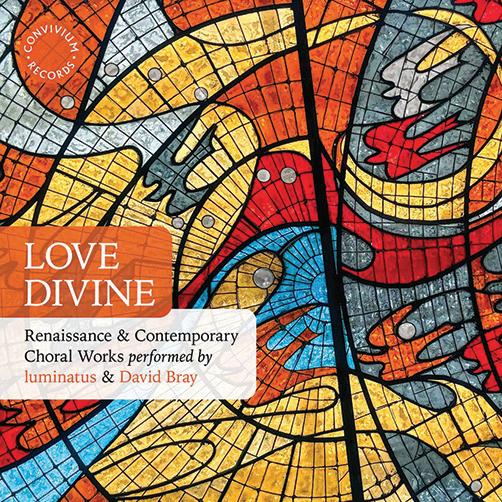
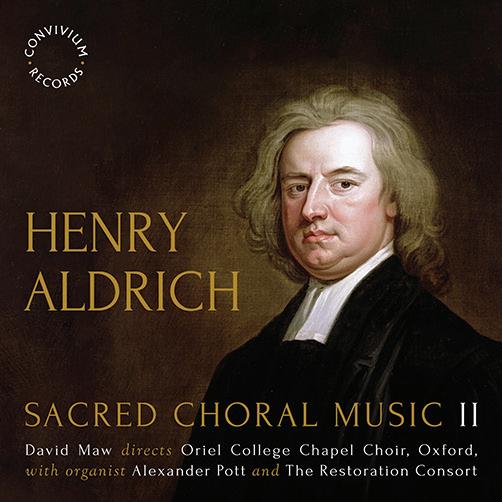


A captivating collection of sacred choral music commissioned especially for the daily services of Christ Church Cathedral, Oxford, conducted by Hilary Punnett with organist Simon Hogan.

An enthralling selection of Renaissance choral music, and works by contemporary female composers, sung with clarity, precision and sensitivity by luminatus vocal ensemble.



Oriel College Chapel Choir have completed the second instalment of the ongoing Henry Aldrich research project, dedicated to bringing his original works to a wider audience.
A spellbinding recording of Clive Osgood’s exquisite Stabat Mater, a 13th century hymn to the Virgin Mary, performed by soprano Grace Davidson, violinist Jack Liebeck, the Choir of Royal Holloway and London Mozart Players under conductor Rupert Gough. AS HEARD ON:


Conducted by Stephen Layton, Polyphony sings Clive Osgood’s beautifully reimagined arrangements of English folksongs, continuing the tradition of music handed down through the generations.
DOWNLOAD AUDIO FILES OR PRE-ORDER YOUR CD WITH FREE SHIPPING AT WWW.CONVIVIUMRECORDS.CO.UK

Barbara Jane Owen, 91, the doyenne of American organ historians, died peacefully on October 14, 2024 following a brief decline caused by a broken hip. She had an illustrious career spanning nearly seven decades as a church organist, organ builder, historian, consultant, author and music editor. In 1994, she received the American Musical Instrument Society’s prestigious Curt Sachs Award.
Born on January 25, 1933 in Utica, New York, to Welsh
immigrants, David and Vera Owen, she was the oldest of three daughters. In her early school years, the family moved to New Haven, Connecticut, and attended Plymouth Congregational Church. Singing in the youth choir, she was influenced by the church’s joint music directors, William and Priscilla Mague. Both were graduates of Westminster Choir College, as was their successor, so she enrolled there.
After receiving her Bachelor of Music degree from Westminster in 1955, Owen held appointments at
First Congregational Church in Portland, Connecticut (1955-58) and First Baptist Church in Fall River, Massachusetts (1958-60). In late 1960, she enrolled at Boston University for a master’s degree in Musicology, received in 1962, studying under the eminent scholar Karl Geiringer. She later took summer courses in Europe at the North German Organ Academy and the Academy of Italian Organ Music.
While in high school, Owen developed a curiosity about pipe organs and began exploring instruments in the New Haven area. This blossomed into a passion after she graduated from college and had a car. At the 1956 American Guild of Organists national convention in New York City, Owen and 11 other young organ enthusiasts met to search for historic pipe organs. Thus began the Organ Historical Society, with Owen as its first president. Its founders aspired to locate extant 19th-century American ‘tracker’ organs and create a comprehensive list.
During the summers of 1961-63, she worked at the Craigville Retreat Center, then affiliated with the United Church of Christ, in Centerville on Cape Cod. There, she instigated the first of several ‘organ transplants’, leading to the formation of the Organ Clearing House, which has since relocated more than one thousand instruments. The first organ was the 1881 E & G G Hook & Hastings, Op 1018, originally installed in a studio at Wellesley College. Owen rounded up some friends and a truck to move it to the Craigville Tabernacle, where it is still used and was featured in a July 2022 concert marking the centre’s 150th anniversary.
In 1963, she relocated to Massachusetts’ North Shore, continuing as office manager, and later a voicer, with C B Fisk in Gloucester (1961-79), and starting as music director at the First Religious Society of Newburyport, an appointment she held for 40 years.
In 2002 she moved on to St Anne’s Episcopal Church in Lowell, Massachusetts, where she remained until 2007, thereafter playing substitute engagements.
Owen was a prolific writer, authoring 13 books and monographs about organs, organists and organ builders. Her first book, The Organ in New England (1979), is the bible of that region’s organ-building history before 1900. Her final book, Pioneers in American Organ Music, 1860-1920: The New England Classicists, appeared in 2021. Internationally, she is known for her biography of British American concert organist E Power Biggs (1987), and as coauthor, with Peter Williams, of The Organ (1988). She also edited multiple collections of organ and choral music from various eras.
She served the American Guild of Organists as a regional councillor and chapter dean and established the Boston Chapter AGO Organ Library, located at Boston University. She also served for 34 years (1989-2023) as a trustee and archivist of the Methuen Memorial Music Hall. As an organ consultant, Owen patiently helped organ committees learn about the organ, equipping them to make educated decisions.
Always brimming with helpful ideas, she occasionally made suggestions which changed people’s careers. Among those who give her such credit are Wayne Leupold, founder of the eponymous organ music publishing house; Stephen Pinel, the third and longest serving Organ Historical Society archivist (1984-2010); and this writer, whom she invited to become a Methuen Memorial Music Hall trustee.
A musical celebration of Barbara Owen’s life will be held on October 13, 2025 at the Methuen Memorial Music Hall.
MATTHEW BELLOCCHIO
On February 25, 2025, we lost one of the foremost church musicians of a generation, Dr Simon Lindley.
Born in London in 1948, to an Anglican clergyman and a mother of Belgian heritage, Lindley was educated at Magdalen College School, Oxford, and the Royal College of Music. He held organist’s positions at various London churches before becoming the first full-time assistant to Peter Hurford at St Albans Cathedral in 1970, where he was also director of music at St Albans School. In 1975, he performed Elgar’s Organ Sonata at the BBC Proms, in a concert alongside the BBC Symphony Orchestra and Sir Adrian Boult.
Without doubt, Lindley will be best remembered for his long and accomplished tenure as organist and master of music at Leeds Parish Church (now Leeds Minster) from 1975 to 2016, and as Leeds City Organist from 1976 to 2017. He inherited an established tradition at the Parish Church, dating back to S S Wesley and Bairstow, and it is a tribute to Lindley’s indefatigable character that the tradition of daily Evensongs continued there into the 21st century, the choir appearing regularly on broadcasts. Regular commissions were also a feature of his tenure including new works by Herbert Sumsion, Philip Moore, Francis Jackson and Bryan Kelly.
Generations of choristers, organ scholars and assistants, many of whom now hold major church, cathedral and other professional positions, were nurtured and learnt their trade from Lindley through his skill and encyclopaedic knowledge. One cannot go far within the musical circles of Yorkshire without mention of Lindley’s name. In an
interview for BBC Radio, he once described himself as a ‘general practitioner in music’, manifest by the number of appointments he held over many years: senior lecturer in music at Leeds Polytechnic (now Leeds Beckett University); director of Sheffield Bach Choir, Doncaster Choral Society, St Peter’s Singers and Overgate Hospice Choir; chorus master of Halifax Choral Society and Leeds Philharmonic Society.
President of the Royal College of Organists between 2000 and 2003 and of the Incorporated Association of Organists from 2003 to 2005, Lindley was also secretary of the Church Music Society and a compiler of New English Praise, a supplement to the New English Hymnal. His lyrical and well-loved setting of the Ave Maria is a staple of almost every church choir and has been sung all over the world. Simon was a freemason for many years, combining his passion for masonry and music as grand organist to the Grand United Lodge of England between 2010 and 2012.
On a personal note, I shall be forever grateful to him for his overwhelming generosity to me when I was growing up as a young organist in West Yorkshire, and latterly as his organ scholar at Leeds Parish Church. He spent many hours teaching, mentoring and guiding me gratuitously. There are many anecdotes about him and his legendary character, always told with great affection by those who knew him. He will be missed by many, as shown by the large number of social media posts and other tributes which have been written since his death. Requiescat in pace.
ALEXANDER BINNS
‘One cannot go far within the musical circles of Yorkshire without mention of Lindley’s name’
The composer Sofia Gubaidulina has died aged 93. One of the leading Russian composers of her generation, she pioneered Modernist techniques and religious themes at a time when both were repressed by the Soviet authorities. She spent the last decades of her life in Germany, writing large-scale works to commissions from Western orchestras, but always retaining strong links to her Orthodox faith and Russian roots.
Gubaidulina was born in Chistopol in southern European Russia in 1931. After attending Kazan Conservatory, she studied at the Moscow Conservatory under composers Nikolai Peyko and Vissarion Shebalin. The uncompromising intensity, radical atonality, and dynamic extremes of her later work were already apparent in a series of early piano pieces, including Chaconne (1963) and Piano Sonata (1965), both of
which have retained significant status in the repertoire. Meanwhile, she made a living composing music for films and documentaries, achieving minor celebrity in Russia with her score for the Kipling-based animation Adventures of Mowgli (1971). Her Western breakthrough came with Offertorium, a violin concerto premiered by Gidon Kremer in Vienna in 1981. The religious and ritualistic connotations of the title are also indicative: like many in Soviet Russia, Gubaidulina adopted the Orthodox faith in the 1970s, despite the state repression, and it would go on to inform all her later work. This is particularly evident in her choral music, including Alleluia (1990), Now Always Snow (1993), and Sonnengesang (1997), which set sacred or spiritually reflective texts with a deep sense of personal devotion.
In 1992, Gubaidulina moved to a village near Hamburg, and most
of her later works were written to Western commissions. In 2000, she was commissioned by Helmuth Rilling’s Internationale Bachakademie Stuttgart to set the St John Passion as part of a project to commemorate the 250th anniversary of Bach’s death. In 2002, she followed this with a complementary oratorio, JohannesOstern, the resulting diptych her largest-scale composition.
Her music was championed by leading Western performers, including Anne-Sophie Mutter, who commissioned In Tempus Praesens (2007), which she premiered with Simon Rattle and the Berlin Philharmonic.
Andris Nelsons and the Gewandhaus Orchestra have also been important advocates, releasing an album of her recent works – Ich und Du, The Wrath of God, The Light of the End – on DG in 2021.
GAVIN DIXON
We offer our congratulations to the following people, who are on the move


Helen Smee
In February 2025, Southwark Cathedral announced Helen Smee as the next Director of Music. She is currently the Director of Frideswide Voices, the girls’ choir of Christ Church Cathedral, Oxford.
George Inscoe
In March 2025, George Inscoe took over as Sub-Organist at St Paul’s Cathedral. Inscoe previously held the same position at Croydon Minster. He continues his career as a recitalist, continuo player and conductor.
Robbie Carroll
In November 2024, Robbie Carroll, former Assistant Organist at Norwich Cathedral, joined Rochester Cathedral as Assistant Director of Music. He is also the Assistant Director of Rochester Choral Society.
Jacob Collins
In January 2025, Jacob Collins was appointed Director of Chapel Music at St Hugh’s College, Oxford. He was previously Director of Music at Crown Court Church of Scotland in Covent Garden.

Adam Field
Announced in February 2025, Adam Field will assume the role of Sub-Organist and Assistant Director of Music at Bath Abbey. Previously, Field was an Organ Scholar at Westminster Abbey.
Hilary Campbell
Associate Conductor of Ex Cathedra, Hilary Campbell was appointed in February 2025 as the inaugural Director of Choral Music at Kellogg College, Oxford. She will lead the formation of Kellogg’s first choir.
Alexander Hamilton
In April 2025 it was announced that CMT committee member Alexander Hamilton will take up the post of Director of Music at the Chapel Royal, Hampton Court in succession to Carl Jackson who retires this year.
Luke Fitzgerald
In April 2025 it was announced that Luke Fitzgerald would replace Anna Lapwood as Director of Music of Pembroke College, Cambridge. He will take up the position next academic year.
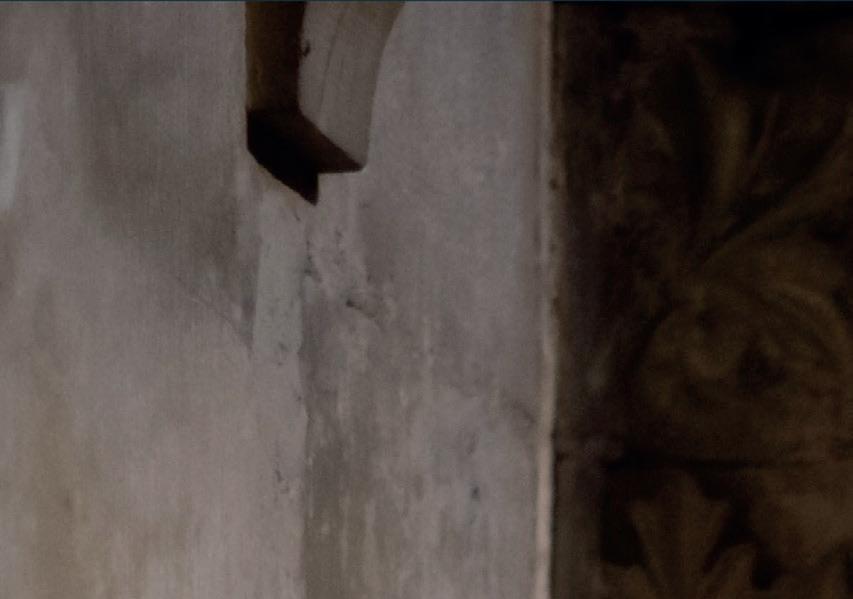


The Sibthorp Circle brings together and recognises the support of all generous individuals who have notified us of their intention to remember Cathedral Music Trust with a Gift in their Will. The Circle is named after our Founder, Revd. Ronald Sibthorp, in honour of the far-reaching impact of legacy gifts.





With thanks to

Michael Antcliff
The Revd Sarah Bourne
David Bridges
Michael Cooke
Eric Cox
Stephen Crookes
Robert Frier
Clarendon Gritten
Rodney Gritten
Julian Hardwick
Edward Hart

Rosemary Hart
Tom Hoffman MBE
Sheila Kemp
Dr James Lancelot
Robin Lee
Jonathan Macdonald
Julia MacKenzie
Kate MacLean
Roddie MacLean
Martin Owen
John Pettifer
Denis Roberts
Marc Starling
David Williamson
Margaret Williamson





And several anonymous supporters

To find out more about joining the Sibthorp Circle or to discuss how you can support the work of the Trust, please contact Jonathan Mayes on +44 (0)203 151 6096 or email jonathan.mayes@cathedralmusictrust.org.uk




Don’t miss the opportunity to join a Cathedral Music Trust gathering near you
FRIDAY 16 – SUNDAY 18 MAY 2025
North-East National Gathering
The Spring 2025 National Gathering will be jointly hosted by Newcastle Cathedral, Hexham Abbey, and Durham Cathedral, taking advantage of the proximity of these three ancient places of worship. The programme includes a talk by Ian Roberts, Director of Music at Newcastle Cathedral, a presentation from the Hexham Abbey Music Department including a talk from Michael Haynes, Director of Music, and a short concert and Choral Evensong at Durham Cathedral with and a short talk by Director of Music Daniel Cook.
SUNDAY 21 SEPTEMBER 2025
Sherborne Abbey Local Gathering
Save the date for a service of Choral Evensong at Sherborne Abbey which will be followed by a talk and an organ recital.
FRIDAY 3 – SUNDAY 5 OCTOBER 2025
Canterbury & Rochester National Gathering
Our Autumn 2025 National Gathering will take place at Canterbury Cathedral. Join us for a long weekend of choral services, recitals, talks, and tours over the course of the three days.
For more information or to book, visit www.cathedralmusictrust.org.uk/events, email info@cathedralmusictrust.org.uk, or call 020 3151 6096 (Mon–Fri, 9am–4pm).
6-8 MARCH 2026
Oxford National Gathering
Save the date for the Spring National Gathering which will take place in Oxford from 6-8 March, 2026
9-11 OCTOBER 2026
The Autumn National Gathering
The Autumn National Gathering will take place between Exeter Cathedral and Buckfast Abbey from 9-11 October 2026.
As a Friend or Patron of Cathedral Music Trust, your generosity allows us to make awards to support the music-making of cathedrals and churches in the UK and Republic of Ireland. In 2024 the Trust made 28 awards totalling nearly £500,000. We speak to some of last year’s recipients to discuss their impact
By HATTIE BUTTERWORTH & HOLLY BAKER
Lincoln Cathedral received a grant of £20,000 to support the employment of a Music Outreach Officer (right)
The current choristers singing at Lincoln Cathedral – 20 boys and 20 girls – come from 20 schools across the city. It must be a logistical nightmare, as the cathedral has also committed to providing transport for all the children. They have three morning rehearsals and three afternoon rehearsals per week, each of which requires transport for the choristers. But could there be a way of finding a larger cohort of children from a smaller pool of schools?
Its grant from the Trust has made it possible to employ Jack Holliday [pictured above] as Music Outreach Officer. Director of Music Aric Prentice says that hiring Holliday was both to provide a recruitment model for cathedral choristers and as part of the cathedral’s commitment to outreach. ‘We’re trying to find the right children who want to commit themselves. We’ve put huge amounts of time into recruiting ever since I’ve been here, so it’s a different thing that we’re trying with Jack, but it’s already proving very beneficial.’
Holliday is a music director with a background in musical theatre, and is delivering a singing programme in four initial Lincoln primary schools. He’s been working with year groups 3 and 4 since November and has already provided the cathedral with a new probationer.
‘He’s got a great little voice on him,’ Holliday says of the young singer. ‘He’s so enthusiastic. In most schools there’s at least four or five other students per class that have the potential of joining the song school.’
It’s hoped that targeting a smaller number of schools will bring in plenty of probationers who already have some sort of musical theory knowledge and base of singing technique. ‘The teaching I’m doing in the schools mirrors fairly closely with how it runs in the song school. They can just slot straight in. We’re doing a couple of the more standard classical musical theatre numbers with them and then mixing in some choral bits.’
This model is not entirely new, and

something the Trust has had experience in facilitating. Prentice explains that the Trust’s advice and guidance has been as beneficial as the financial element: ‘Cathedral Music Trust has been very helpful in guiding us to set it up and explaining how it’s worked in other places. Things such as what age groups we should be targeting. We’ve also had a lot of help from Choral-Hull, which is the Hull Minster scheme, and [Director of Music] Mark Keith,’ Prentice continues. ‘They have a very similar thing which has only been running for about three years, but has already produced huge results.’
For the majority of the school children Holliday works with, singing in Lincoln Cathedral won’t be on the cards. So how can he make sure that the sessions delivered aid the general music education of young kids?
‘My main aim with most sessions, alongside obviously trying to gain students, is making sure that they’re having fun,’ Holliday replies. ‘It’s so important that they’re enjoying it and are engaging in the lessons whether they like singing or not.’
Prentice adds, ‘I think that’s a very powerful thing for the cathedral to be doing – using music of course, but also partnering with schools in a completely different way. Getting children much more engaged with the cathedral and making that connection.’
‘Funding for us is absolutely essential,’ Prentice concludes. ‘We wouldn’t be able to do it otherwise. With the Trust’s expertise and willingness to find the funding for us to be able to do this work. Hopefully it will be wonderful for the schools – it’s already wonderful for us!’
St Ann’s Church, Manchester received a grant of £5,500 to support a project recruiting post-graduate singing students and to provide vocal coaching for associate choir members
St Ann’s Parish Church in Manchester is incredibly focused on the quality of sound of its choir. In October 2023 their previous Director of Music Alexander Rebetge proposed a vocal coaching scheme in partnership with the Royal Northern College of Music. Helen Lacy, Church Warden, explains: ‘He came from a background of high-quality choral teaching and was very focused on improving the sound that the choir makes, as well as an increase in the range of music the choir sings.’
Rebetge put together a plan for two students from the RNCM to come and provide vocal coaching to members of the choir, in order to improve personal confidence and techniques within the choir, as well as delivering the students valuable teaching experience.
Lacy continues: ‘The funding from the Trust has enabled us to realise this ambition. We have been able to offer two vocal studies students from the RNCM an award towards their continued studies to offer coaching
sessions as well as provide equipment and our Director of Music’s expertise to expand their practical experience of teaching.’
‘It’s a two-way process, where our choir benefits but also the students get really beneficial feedback. Our Director of Music can give them advice on the process, help them reflect on their learning and develop their coaching skills.’
Lacy says they have seen a positive universal uptake from the choristers as well. ‘There was a little bit of doubt to begin with,’ she admits, ‘but every single member has given us positive feedback and have said they have learnt a lot from the experience.’
The options for the future of the project are either to continue funding out of church resources or collaborating with RNCM and incorporating this opportunity as part of their course. The students would then get credits towards their pedagogy module rather than a financial payment.
Lacy says: ‘Although we’re not a cathedral, we aim to offer cathedral style worship. We may be an amateur choir but we’re aiming for that perfect sound. We have people from all walks of life, ages, backgrounds that come together and contribute to this path towards it. Achieving a high quality of music but also broadening access to the choir and extending our reach to people who don’t necessarily have a background in church music is at the forefront of this project.’
Guildford Cathedral received a grant of £6,600 to support their Schools’ Evensong Project
When Guildford Cathedral began its Evensong programme aimed at schools, it was hoped that through it the music team could inspire confidence in singing together as a group, and for young students to experience the magic of the cathedral’s space.
The project was initially piloted during the academic year 2023/24 with a local state secondary school and sixth-form college. Throughout the pilot, it was clear that the students and staff were keen to experience more of what Evensong offers: the chance to sing beautiful music and to be part of something bigger. ‘As we have interspersed our lay clerks amongst the students, they have felt more empowered in what they are doing,’ says Katherine Dienes-Williams, Organist and Master of the Choristers at Guildford Cathedral. ‘We hope that the schools with which we work will be inspired to a continued interest in church music and may want to approach other venues to sing Choral Evensong as a visiting choir,’ adds Rebecca Cunningham, administrator of the Schools’ Evensong Project.
The funding from the Trust was offered over two years to expand the opportunity to a current total of six schools, and involve
them in other concert opportunities within the cathedral. Cunningham explains that this project is just the start of the cathedral’s outreach ambitions: ‘We aim to become a partner school with the Surrey Music Hub as part of that effort, alongside working with the Trust.’
‘The services have been extremely popular,’ Dienes-Williams continues. ‘The Quire is full of parents, supporters and regular worshippers.’ Following the most recent Evensong, students from Farnborough Sixth Form College were asked to describe their experience of singing alongside the full-time cathedral choir: ‘It fills you up with a feeling that’s quite indescribable,’ one of them said. ‘I felt very lucky to have the opportunity to take part in something so special... A lot of music students like myself would pay for a similar experience,’ said another.
Looking ahead, one of the biggest hopes for the music staff is to grow the cathedral’s visibility within the musical community: ‘By engaging with Surrey Music Hub we hope to become part of the regional offer in schools, as we know that there is a hunger out there for the experience we are offering,’ concludes Cunningham. ‘Seeing the student engagement with the process, culminating in their own Evensong with our full choir, supported by the professional lay clerks, our changed voices (former boy choristers) and the girls’ choir never fails to be uplifting for everyone involved – me included.’

Leeds RC Cathedral received a grant of £29,500 to support the Cathedral’s choral and organ scholarship programme
‘We’re really delighted to have the support from the Cathedral Music Trust’ says Thomas Leech, Director of Leeds RC Cathedral’s Schools Singing Programme. ‘It’s been really invaluable over the years having this relationship which allows us to offer as much as we can to the children we’re working with.’
The programme works with over 7500 children a week in 75 of the Diocese’s schools. It is this outreach into the community which is at the heart of Leeds’ work. ‘We’re not seeing children who have had prior exposure to cathedral music or children who have
previous knowledge or a cultural background of choir singing,’ Leech explains. Through these sessions Leeds Cathedral Choir introduces the students to choral music and then offers places into their choirs to any students who show enthusiasm and aptitude, regardless of skill level. ‘It’s our job to put the skills there; it’s not the children’s responsibility to know anything, it’s for us to give them the opportunity to learn.’
It is the ‘unevenness’ of opportunities which Leech describes that the Cathedral’s Schools Singing Programme wishes to combat. ‘Some of the schools are drawing their catchments in the worst one per cent of poverty in the UK, and these kids have the potential to really engage with music at a high level, but the opportunities are so uneven.’
Leech continues: ‘Choristers at King’s College Cambridge or St Paul’s are getting a
huge number of resources thrown at them as a result of being a chorister, and we just don’t have access to that financially. So, with the Trust helping us, we can really develop these opportunities for the children and fulfil that potential.’
The opportunities on offer for Leeds Cathedral Choir are indeed impressive: collaborations with singer-songwriter Gabrielle and The Sixteen as well as BBC Radio 3 and Radio 4 recordings. ‘These are the opportunities that then give those children confidence and experience within the musical world. Regardless of what pathway they follow, this will equip them for later life.’
Leeds Cathedral has seven choirs – a pyramid from the Cathedral Children’s Choir (for KS1 children), the Junior Boys and Junior Girls Choirs, Senior Boys and Senior Girls Choirs, Schools Scholars (emerging tenor and bass singers) and Choral Scholars (students in higher education in the city). Then there are a further 12 after-school choirs meeting weekly across the Diocese.
All choristers – and Choral Scholars – have either individual lessons or group coaching (in the junior choirs) through the Trust’s support, as well as having the opportunity to develop conducting and leadership skills (the
older choristers/choral scholars) and organ lessons (organ scholars/choristers). Leech explains: ‘The money from the Trust allows us to really advance the choral scholarships we offer. Our core funding goes into our programmes, because it’s an investment into the future of the cathedral choir, but we don’t generally have very much for resources beyond the day-to-day staffing. That’s why this money has been really transformative.’
‘In fact, two of the choral scholars have now developed enough so that they’re delivering professional work for us. One of our choral scholars conducted in our Remembrance Day concert and is now working with our junior choirs. She works with the seven and eight-year-old girls and gives them a role model. And that’s what’s so important. If you don’t see someone like you achieving it, it’s very hard to imagine yourself in that world.’
‘Our scholarships are not just about getting children into choral music, but a long-term investment into these children, whatever their professional path may be.’
For more information on the Trust’s grant programmes and on recipients of awards, visit www.cathedralmusictrust.org.uk/programmes

Choristers continue to bring sacred music to life in cathedrals and Choir Schools across the UK. But with the government’s removal of private school VAT exemptions, a number of these institutions face uncertainty
By ROBERT GUTHRIE
How can it be that so many child choristers in the British Isles still uphold the tradition of daily sacred choral singing that first developed here around the seventh century?
Amid social media, growing faithlessness and reduced funding, the fact that they number over 3,000, according to Cathedral Music Trust’s 2023 Chorister Survey, is a wonder.
But it is perhaps explained by the existence of a unique choral ecosystem comprising not only parish choirs and a range of local-level school partnerships but also nearly 40 choir schools, attended by around 1,000 choristers.
‘We maintain 40 choristers: 20 boys, 20 girls,’ says the Revd Canon Andrew Stead, Precentor of Lichfield Cathedral. ‘We make sure it’s absolutely clear in terms of equality.’
The boys’ and girls’ choirs sing on respective Tuesdays and Wednesdays while alternating Fridays and Sundays, with the senior choristers of both choirs singing on Thursdays. All choristers, aged 7-13, attend
Lichfield Cathedral School, an independent day choir school.
‘It’s a game-changer to have everyone in one place and wraparound care that works in conjunction with the cathedral and the school,’ says Ben Lamb, Director of Music at Lichfield Cathedral. ‘It also means that we can have daily rehearsals before school.’
‘We’ve attracted a more diverse range of people since we moved to being a day school,’ Lamb adds. ‘Even though we offered a massive offset to fees when it was a boarding school, I think that it was still seen as a barrier by a lot of people that their children would have to go and sleep somewhere else.’
The cathedral and cathedral school also take music beyond the choir stalls through MusicShare, an award-winning outreach programme involving collaboration with The Music Partnership, which supports four West Midlands authorities. ‘It reaches tens of thousands of children,’ says Susan Hannam, Headteacher of Lichfield Cathedral School and a Trustee of the Choir Schools’ Association. ‘There’s been enormous underfunding for years in music education in the state sector.’
The programme runs music projects with 150 primary, secondary and SEND schools annually and has received Department for Education and Arts Council England funding. Workshops involve current and former choristers as ‘Young Singing Leaders’ and culminate in schools giving a concert in the cathedral. ‘This tradition of English choral music is so important,’ Hannam says.
‘Culturally, artistically, musically and historically, it’s so rich.’
Westminster Cathedral epitomises that too.
Aged 8-13, its 20 boy trebles sing five times weekly for its Roman Catholic liturgy.
‘We live and breathe the liturgical year through sacred music,’ says Simon Johnson, Master of Music at Westminster Cathedral. ‘Recently we made a new album. In March we went to the USA. The week before that we sang JS Bach’s St John Passion. In April we commemorated the 500th birthday of Palestrina with a concert in Palestrina and in June we’ll travel to Hungary. This is all within a six-month period and is not unusual.’
Westminster Cathedral’s choristers attend the independent boys’ Westminster Cathedral Choir School, and have boarded from Sunday to Friday since 2019. ‘Choir boarding, with choristers on site, makes it easier to rehearse,’ Johnson adds. ‘There wouldn’t be enough time to fit in rehearsals and services, music practice and instrumental lessons, homework and school activities if there was an unpredictable London commute thrown in.’
‘The advantages of being a choir school are that choristership becomes holistic, encompassing: musical education; personal development, including teamwork, responsibility, perseverance, confidence, resilience, a strong work-ethic and attention to detail; and a fully immersive engagement with a rich repertoire including, in our case, much outstanding polyphony and plainsong, and within a community of choristers from many backgrounds.’
St Mary’s Episcopal Cathedral, Edinburgh, is Scotland’s only cathedral to sing regular choral weekday services. Choristers sing Evensong on Tuesdays, Thursdays and Fridays, as well as two services on Sundays, and rehearse every
morning from Monday to Friday. Lay clerks alone offer Evensong on Wednesdays.
‘The ‘choral tradition’ is far less well-known in Scotland and so it is always even more a priority to let people know about the opportunity to be a chorister, choral scholar or lay clerk, or to drop in and listen to Choral Evensong,’ says Duncan Ferguson, the Cathedral’s Director of Music.
The cathedral’s current 15 choristers attend St Mary’s Music School, Scotland’s only independent specialist music school, which is day and boarding. ‘It enables joined-up timetabling and planning, which helps maintain the routine of regular weekday services,’ Ferguson adds. ‘There is also the proximity of the school, with all the choristers needing to be at the same place at the same time.’
Cathedral musicians continue to reach new audiences. St Mary’s is home to Benedicite, a youth choir launched last year, and there’s a primary-school singing programme and nursery-age singing classes. ‘The interest that is generated in the building and its music can only strengthen awareness of weekday choral services and the cathedral choir,’ Ferguson adds.
While many choir schools are independent, there are a few institutions like Bristol Cathedral Choir School which became a state-funded academy in 2008. Eight choristers from across the city join annually as probationers for years five and six, becoming full choristers for years seven to nine.
Bristol’s 21 boy choristers sing Evensong on Mondays, while its 20 girl choristers sing on Tuesdays. The choirs combine for Wednesday Evensong, alternating full Sundays. Probationers rehearse in respective groups in ▷
the afternoons while full choristers rehearse mornings from Monday to Friday.
‘We make extra time for the probationers in the afternoon,’ says Mark Lee, Director of Music at Bristol Cathedral. ‘They all have a half-hour’s dedicated time before the other choristers join the afternoon rehearsal.’
‘There’s no bar to anyone being a chorister as long as they have musical skills,’ Lee adds. ‘The fact that the school is much bigger is helpful. Music is very highly regarded. We have made massive efforts for the choir and school to function together really well. It’s a proper partnership.’
However, the state model requires careful prioritisation. ‘There are trade-offs,’ says Dr Wade Nottingham, Headteacher of Bristol Cathedral Choir School. ‘We don’t offer necessarily the range of subjects you would see in other comprehensive schools, so that affords us the additional provision for choristers and music.’
Might more independent choir schools turn state-funded? ‘Who knows what will happen following the changes to the VAT?,’ Nottingham says. ‘That avenue may become more attractive.’
Or might they diversify links with state schools? Leeds Cathedral’s choristers come entirely from state schools recruited through the diocesan Schools Singing Programme while Canterbury Cathedral announced in 2023 that its boys’ choir would open to children from other schools.
Costs have risen for independent choir schools since the UK government abolished the 20 per cent VAT exemption on independentschool fees in January. The Department for Education says funds will ‘improve standards and opportunities for the nine out of 10 children who attend state schools’.
It adds: ‘We don’t expect that raising VAT will cause private school fees to go up by 20 per cent. This is because private schools don’t have to reflect the VAT increase in the amount fee payers are charged. On average, we predict the measures are likely to see fees rise by around 10 per cent.’
‘It will be some time before the full effect of the tax is known, as it will influence parental choice for years to come’
But Hannam of Lichfield Cathedral School describes this notion as ‘absolute nonsense,’ saying that they have managed to offset about one per cent. Parents will pay the remaining 19 per cent. Choristers will still receive cathedralfunded bursaries of at least 20 per cent. She adds that while their January ‘Be A Chorister For A Day’ workshop was ‘hugely well attended,’ several prospective families for general school entry last September ‘disappeared into the ether’ following the VAT news.
Edinburgh’s conclusions are similar. While the Scottish Government Aided Places Scheme covers 100 per cent of a few choristers’ fees, others receive a cathedral-funded bursary of at least 33.3 per cent, with parents paying the rest. St Mary’s Music School’s Dr Kenneth Taylor says: ‘We’re fortunate that the Scottish government is able to pay the VAT on its contributions.’ But he says that the school had ‘no option’ but to increase fees by 20 per cent. ‘It’s fairly obvious that if you increase fees you are going to automatically decrease diversity.’
The Very Revd John Conway, Provost of St Mary’s Episcopal Cathedral, Edinburgh, says: ‘The cathedral has agreed to pay the VAT on its contribution. That will add between £12,000 and £13,000 per annum to our costs. The rise in VAT threatens to undermine what we can financially offer to those from challenging socioeconomic backgrounds.’
Neil McLaughlan, Head Master of Westminster Cathedral Choir School, says: ‘It will be some time before the full effect of the tax is known, as it will influence parental choice for years to come.’
As Hannam of Lichfield concludes: ‘Some families have never considered independent schooling. We try hard not to allow finance to be the reason why a child with potential and a supportive family can’t do it. The English choral tradition is a beautiful and precious thing that needs the people who are working hard to keep it going.’
The Trust will be exploring multi-school cathedral choirs in the next issue.
By CHARLOTTE GARDNER
ALDEBURGH FESTIVAL
June 13-29
Choral highlights include Blythburgh Church playing host at sunset to EXAUDI’s first live performance of its Book of Flames and Shadows programme. Another is the BBC Singers and Chief Conductor Sofi Jeannin with lockdown and liberation-themed works by, among others, Britten, Poulenc, Musgrave, plus festival featured artist Daniel Kidane’s The Song Thrush and the Mountain Ash brittenpearsarts.org
BATH FESTIVALS
May 17-25
A celebration of books and music mixing inspirational speakers, consummate storytellers and music in Bath’s historic churches. Bath Music Festival’s choral jewel


As the UK prepares for a summer of music festivals, we highlight some of the finest choir concerts throughout the season, to be found in urban arts centres, cathedrals and rural churches alike

for 2025 is The Marian Consort under Rory McCleery bringing its William Byrd: Singing in Secret programme (including Byrd’s Mass in Four Parts) to Bath Abbey. bathfestivals.org.uk
FESTIVAL
May 3-26
England’s largest curated multi-arts festival this year welcomes Harry Christophers and The Sixteen to perform a programme juxtaposing music composed by a 12th century German abbess, with the ‘holy minimalism’ of Arvo Pärt, plus two contemporary British pieces. Another choral highlight sees the Brighton Festival Chorus join the Royal Philharmonic Orchestra for a nature-inspired programme. brightonfestival.org
ABOVE Blythburgh Church will host one of Aldeburgh Festival’s standout concerts: the first live performance of EXAUDI’s Book of Flames and Shadows
Cheltenham Music Festival celebrates 80 years in 2025, with choral music centre-stage
July 10-27
Concerts running alongside the opera programme this year include The Tallis Scholars bringing a programme pairing the works of 500th anniversary composer Palestrina with those of Victoria. buxtonfestival.co.uk
July 4-12
Cheltenham celebrates 80 years in 2025, with choral music centre-stage. Berlioz’s Te Deum at Gloucester Cathedral, the sacred music of Orlando Gibbons at the Pittville Pump Room, and Mozart’s Requiem at Cheltenham Town Hall all feature. Top-flight performers include Dame Sarah Connolly and the Choir of Merton College, Oxford. cheltenhamfestivals.org
June 14-July 20
May 12-24
Always a festival to make a springtime beeline for, Chipping Campden’s choral highlight this year is Tenebrae’s May 19 concert, I saw Eternity, in St James’ Church – a dramatic programme contrasting JS Bach’s motets with the sacred music of Sir James MacMillan. campdenmayfestivals.co.uk
May 24-26
Based at Dunster Priory Church, the Somerset festival this year has the transcendent voices of The Marian Consort celebrating Palestrina’s 500th anniversary, and joining period instrument ensemble Spiritato for the all-Bach Festival Finale. Other events include an afternoon cream tea concert, a late-night vocal recital, a choral workshop and an inaugural Festival Fete with children’s entertainment. dunsterfestival.co.uk
May 24-June 1
Celebrating Elgar’s legacy in the places that were familiar to him, the Worcestershire festival this year has the English Symphony Orchestra and Festival Chorus filling Worcester Cathedral for a special gala concert with Elgar’s Symphony No 2 and John Ireland’s ‘These Things Shall Be.’ Also celebrated is the 70th birthday of Worcester’s finest living composer, Ian Venables. elgarfestival.org
June 11-15
ABOVE The Choir of Merton College, Oxford are among the top-flight visitors to the Cheltenham Festival
This multi-arts festival’s 2025 classical music programme notably features Chichester Chorale concluding its 20th anniversary celebrations by singing Vivaldi’s Gloria and Buxtehude’s Magnificat, among other works, at Boxgrove Priory Church. Also being celebrated is Orlando Gibbons’s 400th anniversary, through Portsmouth Baroque Choir presenting a viol consort-accompanied concert of his and his contemporaries’ music. festivalofchichester.co.uk
Based in Bridgnorth’s 18th-century Church of St Mary Magdalene, this festival’s periodinstrument English Haydn Orchestra is led by Simon Standage and conducted by Steven Devine. Its major choral event, on 15 June, is Joseph Haydn’s The Creation, featuring soprano Ana Beard Fernandez with Covent Garden Opera singers, tenor Timothy Langston and bass Eugene Dillon Hooper. englishhaydn.com
September 18-21
Praised for its ‘superb combinations of sound and vision’ [Vox Carnyx], in the city’s 850th anniversary year, the Glasgow Cathedral Festival is celebrating community and innovation. There’s a world-premiere commission from Roxanna Panufnik. Roger
Sayer’s Interstellar 10 showcases the majestic cathedral organ, and Fritz Lang’s iconic 1927 film Metropolis is screened with a live score by Cork composers and sisters Irene and Linda Buckley. gcfestival.com
August 17-24
This year’s honouring of the Welsh tradition begins with the festival-opening Cymanfa Ganu, a traditional festival of sacred hymns, with Côr Meibion Aberystwyth. Famed Welsh male voice choir Côr Godre’r Aran also visits, as does Côr Bro Meirion with a performance bringing together the worlds of Welsh and classical music. moma.cymru
June 26-July 13
If you’re yet to see Gaia, Luke Jerram’s touring 3D art installation depicting our planet, visit this eclectic festival for 10 days, at St Wilfrid’s Church, with one especially atmospheric opportunity to experience it at a candle-lit concert by The Marian Consort who will sing underneath it. harrogateinternationalfestivals.com
July 3-13
Set across the medieval churches of Kent’s Romney Marsh, just one hour from London, JAM’s eclectic 2025 programming includes three concerts celebrating Coronation composer Paul Mealor’s 50th birthday, including the BBC Singers performing the UK premiere of his The Light of Paradise for choir and saxophone quartet, and The Chapel Choir of Selwyn College, Cambridge with The Farthest Shore jamconcert.org
August 1-10
Lake District Music celebrates its 40th birthday this summer with a couple of notable choral highlights. Kantos Choir performs its Elements programme, complementing works such as Katerina Gimon’s Elements and Herbert Howells’s Take Him, Earth, for Cherishing with poetry and prose. Then Beethoven’s ‘Choral’ Symphony No 9 is paired with his ‘Emperor’ Piano Concerto No 5. Paul Lewis is the soloist. ldsm.org.uk
May 12-July 14
Featuring Leeds Cathedral’s four-manual Klais organ and some of the finest players from around the world, this festival presents admission-free Monday lunchtime recitals (with a retiring collection, and excepting May 26), and this year includes David Pipe giving a children’s recital as part of the Royal College of Organists’ Play the Organ Year 2025. leedsiof.org
July 8-20
This wide-ranging festival features among its 2025 highlights a 13 July performance in Lichfield Cathedral from award-winning vocal ensemble, Tenebrae, singing Joby Talbot’s Path of Miracles, based on the famous Catholic Pilgrimage to Santiago. lichfieldfestival.org
BELOW Bath Camerata are choir-inresidence at the Presteigne Festival in Wales this August
May 22-31
Perth Festival of the Arts’ choral jewel this year is a concert from the multi-awardwinning ORA Singers under Suzi Digby: a programme featuring Allegri’s famous Miserere paired with Sir James MacMillan’s setting of the same text, plus a new commission by Scottish composer Electra Perivolaris, and further works from Renaissance masters to contemporary voices. perthfestival.co.uk
August 21-25
This much-admired Welsh festival renowned for its advocacy of contemporary composers has Bath Camerata as choir-in-residence and the Jamaican-born British composer Eleanor Alberga as composer-in-residence this year. Bath Camerata will perform Cecilia McDowall’s Da Vinci Requiem with the Festival Orchestra under George Vass, and with their musical director Robert Brooks sing at the Festival Eucharist, and at Leominster Priory where they premiere a new Marian setting by Kerensa Briggs. presteignefestival.com
May 1-8
The Dorset festival this year welcomes Armonico Consort for the first time, to perform its Naked Byrd 2 programme by candlelight. Further choral highlights include
‘...exceptional concerts in Dorset’s beautiful Milton Abbey from the VOCES8 Foundation’

the Festival Chorus performing Mozart’s Requiem and Haydn’s Te Deum, and the Abbey’s own choir singing a concert of English anthems. Organist Thomas Trotter also performs. sherborneabbeyfestival.org
August 22-25
A jam-packed weekend of classical, folk and jazz music in venues across the historic Nottinghamshire town, with Southwell Minster hosting two notable highlights featuring the Festival Voices: works from Duke Ellington’s Sacred Concerts with the Festival Big Band and Marcus Farnsworth conducting Bach’s B Minor Mass with the Festival Baroque Sinfonia. southwellmusicfestival.com
STOUR MUSIC
June 20-29
Robert Hollingworth’s gentle invigoration of Alfred and Mark Deller’s Kent festival this year features a choral spectacular from him and his vocal ensemble I Fagiolini on the afternoon of Sunday June 22: the first performance since the 18th century of works intended for the great Roman churches by Benevoli, Palestrina and Infantas, with the congregation surrounded by the singers. stourmusic.org.uk
SUMMER MUSIC IN CITY CHURCHES
June 18-27
Themed Eternal Light, this year’s festival is book-ended by two of the most beloved requiems, both in St Giles Cripplegate: on opening night, the Fauré, with the City of London Choir (CLC) and Royal Philharmonic Orchestra conducted by Sir John Rutter in his 80th year; then on the closing night, the Verdi, the CLC conducted by Daniel Hyde. summermusiccitychurches.com
THE MUSIC SUMMER SCHOOL AND FESTIVAL
August 2-16
Based at Gresham’s School in Holt, Norfolk, this is the new incarnation of the historic Dartington Music Summer School and Festival, offering around 35 courses a week, ranging from Renaissance Music to Singer Song Writing, with three concerts and talks each day. Choral concerts for 2025 are Handel’s Israel in Egypt and Mendelssohn’s Elijah directed by David Temple. mssf.org.uk
June 20-July 13
Thaxted Festival has both the draw of its picturesque Essex location, and for lovers of choral music in particular, its origins in Gustav Holst’s 1916 Whitsun Festival. This year’s rich programming, supported by orchestra-in-residence the London Mozart Players, features concerts from The Gesualdo Six and the Choir of St George’s Chapel, Windsor Castle.
thaxtedfestival.co.uk
July 26-August 2
The world’s oldest classical music festival returns to Hereford Cathedral in 2025, with major choral works including Mendelssohn’s Elijah, Howells’s Hymnus Paradisi, and Coleridge-Taylor’s The Atonement. There are also premieres by Richard Blackford and Bob Chilcott, with performances from the festival’s own choirs and the Philharmonia Orchestra. See our news story on page 10 for more information. 3choirs.org
June 6-8
Tilford’s 73rd festival coincides with the 25th anniversary of artistic director Adrian Butterfield’s London Handel Players, and
centres on a performance of Bach’s B minor Mass. The opening concert sees LHP collaborate with Scottish folk duo Alasdair Fraser and Natalie Haas, and the weekend concludes with a concert featuring talented students from London and Toronto. tilfordbachfestival.com
July 28-August 2
Another week of exceptional concerts in Dorset’s beautiful Milton Abbey from The VOCES8 Foundation, with the all-age VOCES8 Summer School running alongside. A clear highlight is the festival-closing performance featuring the world premiere of Taylor Scott Davis’s Requiem. voces8.foundation/summerschool
September 17-21
Set across five picturesque North Dartmoor villages, the Whiddon Autumn Festival’s fifth year revolves around a series of choral performances from ensemble-in-residence Corvus Consort, under the direction of Freddie Crowley, including a concert themed on the Song of Songs and world premieres from composer-in-residence Ben Nobuto.
whiddonautumnfestival.co.uk
ABOVE St Giles Cripplegate will host the opening and closing concerts of this year’s Summer Music in City Churches Festival, in London
innovative
By CATHY DEW
In March this year, I paid a visit to St Matthew’s Church in Ipswich, which, in partnership with Suffolk’s Organists’ Association, was playing temporary host to a WOOFYT™.
The WOOFYT’s name, an acronym for ‘Wooden One-octave Organ for Young Technologists’, is also wonderfully onomatopoeic, as its sound is an attractive, gentle ‘woof’, even at the hands of a class of very excited ten-year-olds. I joined the children from St Matthew’s School, situated next-door to the church, to experience the WOOFYT first-hand.
The WOOFYT has been educating and inspiring children for just over twenty years. It was the brainchild of musician Jeremy Sampson (who had brought the WOOFYT to St Matthew’s) and businessman, engineer and amateur musician Bill Cleghorn. Jeremy’s musical knowledge and Bill’s engineering expertise brought into being an instrument that makes the internal workings of a pipe organ visible and understandable for children (as well as curious and relatively uninformed adults like me). Nothing about the WOOFYT is automatic. There is no electricity involved; the operators have to pump and regulate the air flow by hand. While it could never be said to be musically efficient (it takes about 14 people to play a one-octave major scale) the co-operation required makes the instrument accessible to those with no prior musical experience and gives the participants a real sense of achievement when they work together to play a simple melody.
The WOOFYT has evolved from ‘proof of concept’ to ‘working prototype’ to a triedand-tested model that can be assembled and dismantled relatively easily. Indeed, the children of four lucky schools which became
custodians of the original WOOFYTs learned how to assemble their instruments for themselves. Unlike a conventional pipe organ, the instrument can be packed away into a couple of sturdy plastic crates and transported in the back of a car. Over the years, the makers have experimented with and refined the WOOFYT’s design, and the version we saw at St Matthew’s was, in effect, a WOOFYT ‘mark II’.
One would, however, be forgiven for not immediately recognising it as a musical instrument at all. The combination of plastic tubes (apparently comprising, amongst other components, marine toilet-valve housing), flexible hoses and a plasticised cotton pillow could easily be mistaken for a complex drainage system attached to some sort of buoyancy aid. It certainly betrays its inventor’s ‘day job’ as the managing director of a company that made bilge pumps for yachts! The instrument does have some more charming physical characteristics, such as neatly turned handles for the bellows, plywood pipes and a panel into which the instrument’s name is attractively carved. Initially, I thought this was nothing more than a lovely piece of advertising, but it soon transpired to be an important feature in the instrument’s design.
The WOOFYT is the ideal vehicle to explore an impressive range of curriculum areas. It provides a practical way to learn about the science of sound and of pressure, the technology behind pumps and air flow, and the fundamental building-blocks of music. It is, therefore, engaging for those with different skills and interests, be they technological or creative. What, for me, is perhaps more significant, is that it encourages and rewards teamwork and
co-operation. It is impossible to work the WOOFYT single-handed. Excepting the WOOFYT itself, there are no ‘stars of the show’. For the WOOFYT to make a sound at all, everyone has to work together and everyone’s role is equally important.
Jeremy had about an hour to introduce the WOOFYT to each class. He began his workshop with some activities to explore elements of music. St Matthew’s serves an area of Ipswich that experiences significant socio-economic deprivation. Very few of the children had previously participated in any formal musical training and even fewer were learning to play an instrument. The majority were learning musical terminology for the first time, and they ‘lapped it up’. We were kept on our toes with some call-andresponse rhythms, a song to illustrate pitch and a game to demonstrate piano and forte.
After a lot of fun exploring musical dynamics, we were introduced to the concepts of simple fluid dynamics – the science behind how a pipe organ works. Drawing on examples within everyday experience, we learned about the crucial piece of technology that allows a pipe organ to function, namely, the ‘non-return valve’. Jeremy showed us a version made of paper, which presented the concept very simply (even I understood it). The children were asked to think where else there might be valves that allow a constant flow in one direction only. They came up with diverse examples, from a cat flap to a football to the chambers of the heart.
Having established how the instrument receives its continuous flow of air, we next learned how a flue pipe makes a sound. Through a series of experiments, we discovered that sound travels via vibrating air molecules, that a pipe’s ‘mouth’ initiates these vibrations as the air flows over it, and its length determines its pitch. A special woodand-Perspex model illustrated how the depression of a button lets air from a chamber into the pipe and, as if by magic (but actually by science), the WOOFYT made its first sound.
Then came the moment we had all been waiting for: the opportunity to have a go. Two children were chosen to pump the bellows, four used the wooden ‘sign’ to apply the necessary, even pressure on the reservoir (keeping an eye on the ‘manometer’ to regulate it) and others operated the buttons


ABOVE The WOOFYT sessions are described as ‘engaging, inspiring, fun and informative’
CATHY DEW
Cathy Dew is Programmes Director for Cathedral Music Trust
that allowed air from the chamber beneath into the pipes. Our first tune was ‘Twinkle, twinkle, little star’. Everyone knew the melody, so we were able to use a chart containing the words and numbers corresponding to the WOOFYT’s pipes to learn which keys to depress in order to play all the right notes. It was incredible to watch how quickly children with very limited prior experience picked up the concepts and worked together to play a tune. After a couple of rehearsals, they had grasped the melody and mastered the timing and Jeremy was able to bring in extra players to provide some harmony.
The half of the class that had, so far, been watching, then had the chance to play. This time the melody performed was ‘Happy Birthday’, and those of us not playing formed the choir to sing along. It wasn’t Stanford in C, but it was a very simple participatory example of what church musicians actually do; what’s more, it was enormous fun!
Throughout the workshop the children were focused and 100 per cent engaged. Their teacher told me that several spoke English as an additional language (there are over 50 languages represented at the school) and that many had special educational needs. Neither were a barrier to their full engagement. Those who would usually have one-to-one support were able to participate without additional adult help. One teacher remarked that children who often struggled academically were just as involved as their more able peers; another commented that the session was ‘engaging, inspiring, fun and informative’. And what did the children think? Samuel in Year 6, told me it was ‘very interesting how vibrating air could be turned into a song’ and Ayo said she had been
‘Wouldn’t it be wonderful if the WOOFYT motivated one or two of the children to become our organists of the future?’
‘fascinated’. Both told me that they would love to learn to play a conventional organ.
And this was the beauty of the workshop’s taking place in the church, because, to round everything off, Jeremy took us over to the console of the church’s fairly modest but well-maintained pipe organ. After our experiences with the WOOFYT, we all had a good understanding of how the instrument worked, but the children were awe-inspired to discover that what had taken the cooperation of 14 on the WOOFYT could be achieved by one person, with the aid of a little electricity, on a ‘real’ organ. We were treated to snatches of Harry Potter (which we recognised) and Widor’s Toccata (which we didn’t) and explored the qualities of a variety of different stops.
The church resounded to an enthusiastically chorused ‘thank you’ as the children walked back to their classroom and Jeremy enjoyed a well-deserved break. I left, having been inspired, as Programmes Director for the Trust, to explore ways in which we can give more young people the opportunity to experience not only the joys of the WOOFYT (of which there are many) but to get their hands on a conventional pipe organ and access to the teaching that will help them make the most of it. We are all too aware of how difficult it is, particularly for children from disadvantaged backgrounds, to take up the instrument. As Jeremy said to the children of St Matthew’s, ‘this instrument is here, right next-door to your school, and you could come here every day to practise.’ I was left in no doubt that the children at St Matthew’s had had an inspiring ‘WOOFYT experience’, wouldn’t it be wonderful if it motivated one or two of them to become our organists of the future?

Out of term time and during holidays, cathedrals across the UK become alive with international choirs singing the services. But this marriage of music and daily prayer offers more than pure convenience
By CLARE STEVENS
February half-term was a good week to be researching this article, as my social media timelines filled up with posts from church musician friends who were singing, playing or conducting in unfamiliar ‘quires and places’ over one of the weekends. One had even written a new Te Deum to match a Jubilate from three decades previously that a colleague wanted to perform at Matins as part of a cathedral residency. Another used his cross-country train journey from one cathedral city to another to document his reflections on several years of similar expeditions, and then posted a photographic diary of his choir’s experience: from their first rehearsal and the jaw-dropping experience of hearing the ‘alleluias’ in Bairstow’s Let all mortal flesh
overlapping across the three-beat rests in a huge acoustic to a formal photo at the end of their last Evensong.
In winter these expeditions to deputise for in-house cathedral choirs are usually fairly short and close to home, but during the long summer vacations it is increasingly common to see choirs from Europe, America or even Australia and New Zealand taking up residence for a week at a time in the choir stalls of UK cathedrals.
The attraction for a US choir is obvious, of course: nothing beats the magic for singers brought up in such a young country of singing the great masterworks of the Anglican and Pre-Reformation church in cathedrals and abbeys that composers such as Byrd, Tallis, Purcell and Wesley would have known.
PHOTOGRAPHY:
The Calvary Choir, when visiting Lincoln noted how ‘it was wonderful looking round as we rehearsed at the stained glass and all the architectural details.’
Dr Alan Lewis, Director of Music at Calvary Episcopal Church, Pittsburgh, Pennsylvania, says his most thrilling memory of his choir’s first ever UK residency in the summer of 2024 was performing music by Byrd in St Hugh’s Choir at Lincoln, just inches away from the plaque in the floor commemorating the 400th anniversary of the composer’s death and his ministry of music in that place.
Lewis has been at the helm at Calvary for 27 years, and is a committed Anglophile, but had resisted requests to bring his choir over to England because he felt it would be selfindulgent. He then sang with a friend’s choir in Salisbury and Durham and changed his mind. Fundraising in Pittsburgh began, but plans had to be put on hold because of the pandemic and the original destination of Oxford was changed when it became apparent that accommodation there would be too expensive for the choir members. Lewis credits their travel agent, Simon Baldwin at Cheltenham-based Charter Travel, with finding them a slot at Lincoln and sorting out an itinerary that also gave them time to see some sights nearby and fit in a trip to York. ‘They specialise in bringing American choral groups to England and he’s a great resource to people… he’s been doing it for years and he knows all the pitfalls.’
Joanna Schulz, an alto with Calvary choir, is full of praise for the local tour guide who not only showed them around the city of Lincoln at the start of their visit but came to three of their services in the cathedral. This is the sort of added extra that can really help to enrich the trip for the members of amateur church choirs. ‘We were all awestruck by the
experience of singing in such an historic building, especially those who had never been to England before. I have, but never to sing, and it was wonderful looking around as we rehearsed at the stained glass and all the architectural details. And the congregation and clergy couldn’t have been more welcoming.’
An important part of planning a cathedral residency is choosing what repertoire to bring. While choirs are understandably keen to savour the resources of a powerful organ and exciting acoustic, and to perform the most famous liturgical works in the churches for which they were written, it’s important to bear in mind the stamina of the singers who may not be used to singing for several hours every day, especially after a long journey. Perhaps the touring choir consists of the singers who were able to afford time and money for the trip, so some of the best musicians had to stay at home. If that’s the case, it’s best to be cautious and schedule less ambitious repertoire that can be sung well. While some cathedrals can offer generous amounts of practice time for the organist to get used to the unfamiliar instrument, most cannot, so that should also be borne in mind.
Another constituency to think about is the regular cathedral congregation who will be listening to lots of different choirs over the summer and don’t want to hear the same service settings and anthems every week. ‘Spare us another Dyson in D or Howells’ Coll Reg!’ pleads one congregation member. ‘I always look forward to American and Canadian choirs coming, because we get some music that is new to us. I recall one American group bringing a very fine violinist who played from the choir screen during communion, and it was incredibly moving.’
For their trip to Lincoln, Lewis chose some American music that he hoped their listeners would not have heard, some pieces everyone would know and some Byrd. He did not deal directly with the music staff or the precentor of the cathedral to have his choices approved, but with the music department administrator. ‘Once we arrived, the key people were the vergers, who could not have been kinder or more helpful and lovely.’
Establishing good relationships with the duty vergers is absolutely crucial for a successful residency, according to every musician with experience of cathedral visits. There are a few horror stories in circulation about cathedrals both in the UK and further afield where staff are either unwelcoming, unhelpful or in a few cases positively
‘Dr Hanna Rijken’s survey yielded some eloquent reflections on the transcendent significance for church musicians of feeling that they are a link in a long-standing tradition of sung praise’
obstructive. It is perhaps worth reminding anyone reading this who has responsibility for hosting visiting choirs of their importance in providing music for both your home crowd and tourists during holiday periods. And there is a missional element for the cathedrals, too – better, surely, for singers and organists to be raving over coffee back in Texas about the thoughtfulness of the verger who showed them an easier access route from the car park to the vestry than sharing a shocking anecdote about having to rehearse in a meeting room rather than in the cathedral’s song school?
Positive experience of interactions with staff on residencies at English cathedrals has even inspired some Dutch singers to investigate taking on the role of verger in their home churches, according to a survey recently carried out by Dr Hanna Rijken, whom some members of Cathedral Music Trust may have heard speaking at last year’s Cathedral Music: New Generation Perspectives conference, about her research on the popularity of such residencies in the Netherlands. Dedicated organisations such as Schola Liturgica have been set up to facilitate choir trips to England. Rijken’s survey yielded some eloquent reflections on the transcendent significance for church musicians of feeling that they are a link in a long-standing tradition of sung praise; of their souls being uplifted by the marriage of music, architecture, daily prayer and the rituals within the liturgy, so that ‘everything is in harmony’. Many respondents highlighted the intensity of the experience – the process of learning and singing a vast repertoire of music within a short time frame was described as demanding, yet deeply enriching. That is an important part of the appeal for parish choirs that normally meet just once or twice a week. ‘A summer residency at a cathedral provides the perfect balance of just enough singing to get you really working well as a choir and enough time to spend properly getting to know each other,’ says Jonathan Wikeley, Director of Music at All Saints Church, Fulham, in South-West London. ‘We rehearse for an hour and a half to two hours in the morning, have some time off and then meet for another rehearsal before Evensong and it works a treat.’ For a big choir like
Calvary, says Schulz, their English tour enabled people who normally only get to know the singers in their own voice part to forge new relationships. Lewis says this bonding element to the trip turned out to be even more important than he expected and has continued to bear fruit on their return home.
There is also a thriving culture of choirs that exist solely to take part in residencies, bringing together singers from around the country or around the world. Chris Bond formed Te Decet Hymnus (TDH) in 2018, with an initial group of 20 singers that has now grown to more than 50.
‘I had lots of very good singing friends, some who knew each other, some who didn’t, and it grew from there,’ he explains. ‘Everyone is there by my invitation, with many being friends of existing members. Having a large number of singers means that I don’t usually struggle to have sufficient singers of each part. Not everyone comes to every event, but some do. I don’t set a minimum requirement, but have a relaxed approach to encourage singers to come when they can.’
The long list of cathedrals where TDH has sung includes St Paul’s London, Winchester, Rochester, Bristol, Manchester, Norwich and Llandaff, and this year they will add Durham and Ely. Bond is proud of his choir’s 100% record of being asked back, which not every visiting choir is: ‘I know what the standard required is and I know the standard of my choir. Not everything is perfect, but no one expects it to be; I have only ever had positive comments from clergy, congregations and cathedral staff, sometimes with helpful but positive ‘pointers’ towards getting things as right as possible.’
TDH singers pay for their own music, accommodation and food, though there is a small contingency fund to help singers who would otherwise be unable to take part. Members come from a variety of backgrounds. ‘Some belong to parish choirs, others are semi-professional musicians who like to sing in the most amazing places with like-minded people. Coming together to sing some lovely music in beautiful buildings is not all that we are about. It’s about friendship and having an enjoyable weekend too!’
As the music world marks 500 years since the Italian composer’s birth, we examine Palestrina’s influence on choral music in more recent times
By EDWARD BREEN
Sometime in 1987 I joined Newport Cathedral Choir, a decision fuelled by news of a trip they had just made to Canada; an impossible level of adventure at that time. Later that year, I would have opened The First Chester Book of Motets: The Italian School for Four Voices – with its striking cover of The Virgin and Child by Albert Cornelis – for the first time to sing Palestrina’s Sicut cervus and Super flumina I quickly discovered an appreciation for this a cappella music, so I combed radio schedules and our town library’s LP collection to find more: the Choir of King’s College, Cambridge (David Willcocks) singing Palestrina’s Stabat Mater, and Westminster Abbey (Simon Preston) singing Missa Papae Marcelli . But then our director of music, Christopher Barton, introduced us to Bruckner’s Os justi and Stanford’s Beati quorum via and I was quickly hooked on them – works which despite spanning a few centuries made an obvious connection with Palestrina in my young mind.
Exactly a decade later, and entirely due to those happy chorister years, I chose a music degree which included a module on Palestrina and counterpoint. However, music theory, I quickly discovered, was not what I liked. What I had found so enchanting as a child was the elegance of Palestrina’s individual lines, how between each phrase it seemed so natural and unforced to find the next starting note and all the while making such a complicated and beautiful whole out of such uncomplicated and modest materials. Theory couldn’t explain that alchemy. Talking to members of Stile Antico recently (Gramophone, 02/25 ) I discovered that I wasn’t the only one who felt this way, and it made me wonder how many music
students might have dismissed Palestrina as dry, pre-fugue counterpoint unless they were lucky enough to sing polyphony as choristers. In this respect I consider our choral tradition is every bit as valuable as youth orchestras, sports clubs and coding bootcamps; practical experiences which enrich young lives.
Palestrina’s music was well respected in his lifetime; the Cappella Sistina sang it regularly both during and after his tenure with them and considering the popularity of Johann Joseph Fux’s great Palestrina study, Gradus ad Parnassum (Paths to [mount] Parnassus), we can be confident that it was studied throughout the 18th and 19th centuries too. Thanks to research by Katharine Ellis and James Garratt, we also know much about the 19th-century reception of his works beyond the Sistine Chapel and outside Italy.
As part of my own personal Palestrina pilgrimage this year, I’ve been thinking about a few of the more unusual examples of his lingering musical influence. This started when I read on the website of Galerie de Lardemelle that in the 19th century there were seven depictions of Palestrina by French artists from Alcide Boichard (1844) to Auguste de Pinelli (1863). Those dates made me think of Liszt’s grand tour and the intriguing title of his work ‘Miserere d’après Palestrina’, the eighth piece of his midcentury piano cycle Harmonies poétiques et religieuses. Disappointingly, it doesn’t match a known Palestrina work, but director of the Liszt Museum, Zsuzsanna Domokos, has explained that Liszt was unlikely to have intended to mislead his audience, rather he probably drew on the expression ‘alla Palestrina,’ which in Italy, ‘was mostly used


as a collective term for the musical language of Palestrina and the Roman school [...] or as a synonym for the term ‘stile antico’.’
Yet while Liszt referenced the generalities of the style and used Palestrina as a synonym, Wagner got down to specifics by editing Palestrina’s Stabat mater which, in my opinion, casts a long shadow over subsequent performances. Wagner’s dynamics are particularly poignant on O quam tristis and, I fancy, informed that famous Willcocks’ record I loved so much as a child.
Despite this flurry of 19th-century continental activity, there seemed to have been less influence in England. Writing in the proceedings of the Royal Musicological Association in 1899, Henry Davey pointed to a rare, ‘epoch making’ performance of Missa Papae Marcelli at St Paul’s Cathedral, adding: ‘only in Germany I believe can performances of this composer be often heard’. At the start of the 20th century that changed rapidly with the foundation of Westminster Cathedral Choir under Richard Terry – to the extent that Stanford encouraged his Royal College of Music students to take a bus there and thus hear ‘Palestrina for two pence’.
Suzanne Cole, author of T homas Tallis and his Music in Victorian England , has written that a ‘dramatic revival of interest in English church music and its history’ occurred in the 1840s and quotes a wonderful article on church music in the 1846 English Review which stated ‘No one, we conceive, is
satisfied with the state of church music […] Happily there are gleams in the sky at this present time, many cheerful signs of awakening zeal, longings of the heart for the old songs of the temple, and the old skill in singing them.’ Cole’s research focuses on the painter William Dyce, who made several trips to Rome where he heard members of the Sistine Chapel singing the music of ‘Palestrina, Allegri and the ancient school’ at the home of the Prussian minister to the Vatican. Experiences which led him to reflect in The Christian Remembrancer (1841) that Palestrina and Raphael were ‘representative of the perfection of an epoch in art.’ Back in England, and under Dyce’s influence, the Motett Society included works by Palestrina in their Monday evening meetings called to ‘study and practice […] the ancient Choral Music of the church […] those sacred compositions of the best masters down to the middle of the 17th century.’ Interestingly enough, Dyce drew the line at Purcell because he ‘wafted full sail on the theatrical and fl aunting spirit of his time.’ Quite! ▷
inspired
Richard
‘If we think Palestrina really is a genius then we ought to fully embrace his complexity: exquisite polyphonist, double-choir, high-energy, quasi-homophonist, and madrigalist’
With all this in mind we can safely acknowledge Palestrina as an influence on our Anglican choral tradition and I would suggest there is plenty to inspire us during this anniversary year.
I was still at school in 1994 when we commemorated Palestrina’s quatercentenary (400 years since his death). Now, some 30 years later as we mark the quincentenary of his birth, it provides an opportunity to ruminate on what has changed over these past three decades. As we have seen, a lot more research, particularly about the Victorian revivals of choral singing, the Cecilian movement, and the early music revival of last century, has been published. The Sixteen, The Tallis Scholars and other professional ensembles like them, have recorded many more masses and motets meaning modern editions of Palestrina are easy to come by online. However, I well remember that Peter Phillips perhaps best caught the spirit of the moment when writing in the journal Early Music (in 1994) in an article entitled ‘Reconsidering Palestrina’ that Missa Papae Marcelli was still his most performed work and laying down something of a challenge by suggesting that ‘Perhaps by the next anniversary, in 2025, people will be competing to record his complete madrigals.’ Yet while Concerto Italiano’s 2008 recording stands out in my mind, I’m hard-pressed to think of too many other albums that feature a Madrigal by the ‘prince of music.’
The more I think about this current anniversary, and the more I revisit favourite writings about Palestrina, the more I find the standard reading of Palestrina’s perfect polyphony only works if you consider just those masses that are frequently heard, but wears thin if you listen to madrigals and the more rumbustious motets such as Dum
complerentur. Peter Phillips also wrote that ‘It is worth observing in passing that Palestrina’s legacy to his immediate pupils was not so much as a Franco-Flemish contrapuntist but as a double-choir quasihomophonist. In this context I find it ironic that more recent generations have spent so much of their time concentrating on a method which Palestrina’s own pupils possibly found un-congenially academic.’ I think that still stands true today and if we think Palestrina really is a genius, then we ought to fully embrace his complexity: exquisite polyphonist, double-choir highenergy quasi-homophonist and madrigalist. I’m OK with all that.
So I suggest we use this anniversary to enjoy and explore Palestrina’s music: by all means don’t hold back on Missa Papae Marcelli but do, if you can, try to broaden your concept of ‘alla Palestrina’ with some of his other works. The old Palestrina favourites worked for me, as I was introduced to a whole world of music through singing Sicut cervus and the Missa brevis in weekly services, and I’m sure many more will happily be initiated into Palestrina’s music this way. At the same time, we do need to reconsider that ‘saviour-of-church-music’ story to make sure it doesn’t eclipse his other works. In short, for this year’s anniversary let’s flood the soundscape with context and celebrate Palestrina as a quasi-homophonist, madrigalist and, crucially, paradigm for the later music that we sing in our great Anglican cathedrals today.
Hopefully you can hear Palestrina’s music live in a cathedral near you. I, for one, will be hopping on a bus to hear ‘Palestrina for two-pence.’ Well, Palestrina for £1.75, but that’s inflation for you!












There’s an immense skill in writing for youth choirs – get it right, and they can absolutely shine. One of the UK’s most in-demand composers explains how he approaches composing for young voices
By WILL TODD
WABOVE Composer Will Todd with the Cantabile Youth Singers
hen the red ‘Live’ light blinked on at the start of the BBC worldwide broadcast from St Paul’s Cathedral in July 2012, I was about to experience one of the most exciting moments of my composing career. My new anthem The Call of Wisdom had been commissioned as part of the Diamond Jubilee celebrations for the late Queen Elizabeth II, and 60 specially auditioned young singers aged between ten and 13 from all over the UK were about to give the first performance in front of an audience of millions and Queen Elizabeth herself. I looked down from the safety of the organ loft where organist Simon Johnson was belting out fabulous fanfares and hymns and looked at the young people waiting to sing. They had been seated for some time and some of them looked quite tired and anxious. I sat there nervously wondering ‘how will they sound’? When the part of the service came for them to sing, they stood and the
first chords of the introduction were sounded on the St Paul’s organ. They drew breath, and along with the voices of St Paul’s choristers and the choristers of the Chapel Royal, this ‘Diamond Choir’ of 60 young voices began the soft opening phrases of Michael Hampel’s wonderful text based on Wisdom 8 ‘Lord of Wisdom, Lord of truth...’. Where there had been tired faces, there was now an incredible look of focus and energy and a fabulous sound of youth voices heard together. From the moment they began to sing, my nerves calmed – the piece was in good hands! I felt that I had done my job – I had given them the notes and now they were filling them with musicality, lyricism and emotion. All singers bring humanity and life to choral performances but young voices can bring a special dimension of emotion, and the cathedral resonated with their singing. When I am writing for choirs I try to imagine that I am there, singing at the first
performance. I also try to imagine being in the space and particularly the acoustic that the piece is to be performed in. I try out lines with my voice and harmonies on the keyboard until I find a phrase that seems to ‘have something’. Sometimes it’s a long phrase like the opening of my carol My Lord Has Come where the whole musical line seemed to present itself; at other times it’s just one small but crucial musical gesture. With The Call of Wisdom it was the words ‘I am here, I am with you’ that inspired a certain chordal progression and made me think ‘this is it’. This method of ‘getting into’ a new composition can be a fast process or very slow and frustrating – depending on that strange thing we call ‘inspiration’. Anyone who has ever written or created anything will know that inspiration is sometimes there in abundance and sometimes seems to be utterly lost and we spend a long time searching for it. I have decided that patience is the key to this so I try to keep writing and having ideas even if I keep on putting them in the bin.
Young singers can have tremendous impact when they sing, and yet they need the right material to bring the best out of them. Too complex and the technical demands can start to obscure their natural brilliance and communicative power. If it’s too simplistic, they can sometimes sense that they are not being trusted to take control of the song and our emotions. Somewhere there is a sweet spot where they know that what they are singing is important and valuable and when that happens they can give us some of the most powerful musical performances you will ever hear. And it’s not just about ‘vocal excellence’, although The Diamond Choir had that in abundance. There is an innate honesty in youth singing which, if we can trigger it in the words and melodies we create for them can produce a really moving experience for the listeners.
Over the years I have had the good fortune to be asked to write a lot of music for young voices, ranging from music for cathedral choristers through to songs for primary schools. My method doesn’t really alter in the sense that I always work hard to find a powerful melody and harmonic movement that I feel they will be inspired by. Many composers have and continue to write brilliantly for young voices and it’s not simply about the style or genre of the music. Britten wrote wonderfully for young voices, and there are so many others, some well known, others less so: Bob Chilcott, John Rutter, Janet Wheeler, Cecilia McDowall, Jonathan
Dove spring immediately to mind – and this is just within the UK.
Knowing the context of the first performance is always important, whoever you are writing for, and there are many things that you can get wrong as a composer of choral music. For example, if you write music with a complexity requiring more rehearsal time than is available, then the piece might not achieve what the commissioners were hoping for. Similarly it’s important to match the style and energy of your music to the occasion for which it is intended. In 2022 I worked on an interesting project for the Bishop Chadwick Catholic Education Trust, one of the Catholic Diocese Education areas in East Durham and Sunderland. The aim was to create a new mass setting (in the new Catholic translation) that could be used across primary and secondary schools for celebrating mass. In order to ensure flexibility of use, I had to make sure that the music had a good ‘top line’ so that it would work well in unison while also having SA, SAB and SATB lines available for possible wider use or for when integrating with an adult or more experienced choir. It was also important to have easy to use resources in terms of learning and backing tracks to aid the preparation of the material. I made sure the movements had good melodies and rhythmic energy without being overly complex or long. It was a real delight to finally hear it come together at Newcastle Catholic Cathedral when we had the combined forces of the five secondary schools alongside a volunteer adult choir using it in a special mass celebration.
Whether I’m writing liturgical music or secular, whether the words are my own or I am setting specially written or pre-exisitng texts, I have one rule when it comes to youth choirs and young voices: to create music that they will feel they want to sing.
This year I have had the honour to be involved in a project as part of Bradford 2025 UK City of Culture with the Royal Ballet and Opera, Opera North and Northern Ballet in collaboration with 35 primary schools in Bradford. At the end of the performance, the children will sing a setting I’ve written of a fantastic Ian McMillan poem called Leap. I’ve used all my experience to try to ensure that when 2500 children sing together in the finale it will be a stunning and life-enhancing experience first of all for them, and then for the whole audience. Hopefully I’ve got it right, and just like at St Paul’s Cathedral in 2012, the young voices will thrill us with their song.
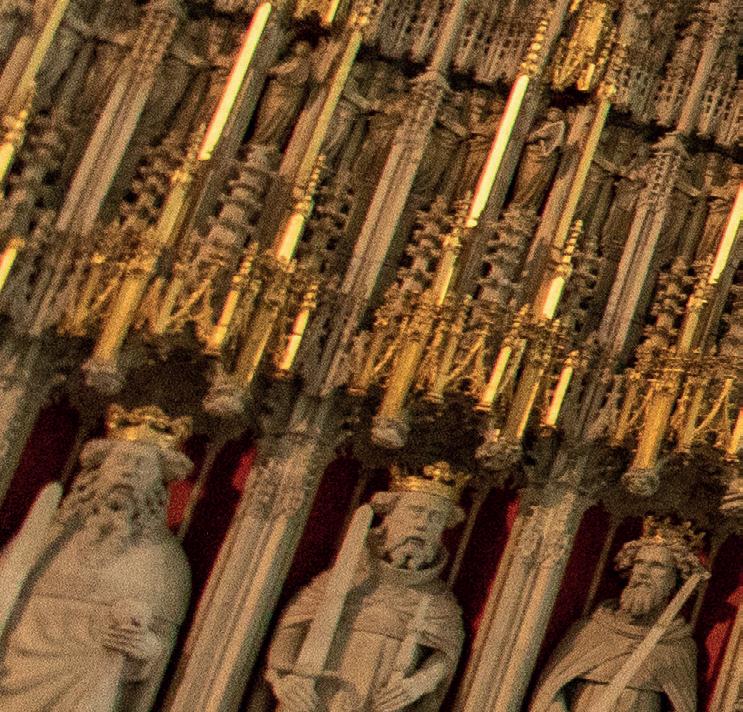


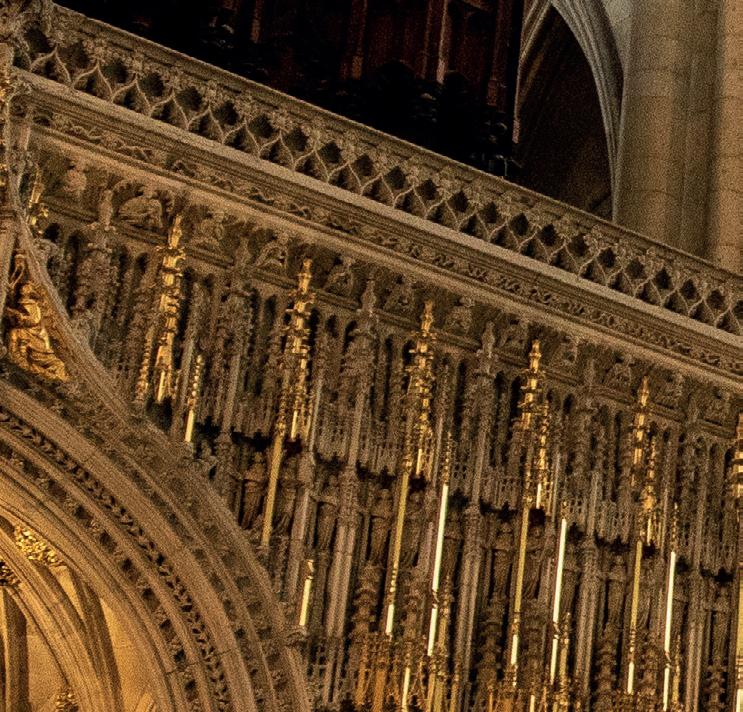
Richard Creed
Lady Sarah Gough
Julian Hardwick
Jonathan Macdonald
Richard Moyse
Iain Nisbet
Kristina Vi
Michael Wilson
Anthony Biddle
Margaret Davis OBE
Colin Dudgeon
Dr Michael Emery
Stephen Emery
Richard Gabbertas
Jason Groves and Charles
Owen
Ester and Michael Harries
Simon Hyslop
Julian Kelly
John Meyrick-Thomas
Nicholas Parry MBE
Dr John Penniston
Dr Isobel Pinder
Gavin Ralston
Graham Robinson
Abigail Sargent
Philip Shirtcliff
Joyce Smith
David Tilly
Dr Christopher White
Susan Williams
John Wilsher
Anne Wilson
James Ainsworth
Ros and Peter Allwood
Ralph Allwood
Sooty Asquith
Kenneth Bain
Richard Baker
Ann Bartleet
Malcolm Beer
Anthony Bowles
David Bridges
Nathalia Britt-Bird
Nigel Brown
Lady Hilary BrowneWilkinson
Stephen Buckle
Dr Malcolm Clarke
Lindsey Cooper
Kieran Cooper
Lady Gillian Curtis
Hilary Davies
David Doggett
Jean and Jeremy Duerden
Kathleen Duncan
Richard Duncan
Thomas Edwards
Martin Eldred
John Ellis
Andrew Fairhead
Professor Alison Firth
Henrietta Fraser
Roma Haigh
Dr Philippa Hall
Jill Harpham
Peter Hignett
Alan Hodgetts
Dr Julian Holloway
Elizabeth Iles
Susan and David King
Jonathan Lancashire
Michael Langton
Mark Lawrence
Diana Lazenby McLaren
Bridget le Huray
Janet Linington
Rosalind and Philip Lund
Sarah MacDonald
Jonathan Mayes
James Mcandrew
Dr Jenny McKay
Patricia McLaren-Turner
John Mitchell
Andrew Nethsingha
Ann Northy-Baker
Fiona Olson
Neil Page
Katharine and John Parsons
Anna Phillips
Oliver Piper
Nigel Press
Melvyn Roffe
John Rootes
Keith Ross
John Saunders
Professor John Saunders
Robert Scott
Dr Simon Shorvon
Moyra Skenfield
Gordon Slater
Mike Smyth
Margaret and Patrick Stables

Clive Stirling
Revd Canon David Stone
Timothy Storey
William F. Tell
Antony Timmins
Revd Paul Towns
Rob Uittenbosch
Dr Elena Vivori
Michael Ward
David Weait
Simon Webb
Pam and Nigel Whitling
Oliver Willmott
Revd Michael Windridge
Jo Windsor
Brenda Wright
Professor Joan Adams
Dr Nigel Allan
Nick Allan
Dr Simon Anderson
Stefan Anderson
Dr William Apedaile
Dr Jonathan Arnold
Michael Ash
Florence Bachelor
Nigel Bailey
Elizabeth Baird
Nigel Bairstow
Isabel Bangs
Revd Canon Philip Banks
Jean Barber
Michael Barker
Martin Bartlett
David Bawtree
Professor John Belcher
Christopher Bell
Sonia Bell
Christopher Benson
Gerhard Biss
Robert Blackman MBE
Mark Blackwell
Dr Judith Blezzard
David Blumlein
Stephen Blurton
Sue and Richard Bonnie
Philip Booth
Joan and Michael Bosworth
Roger Boulton and Ruth
Dunlop
Stephen Bourne
Paul Bradburn
Christopher Brewer
Revd and Mrs Brice

Josephine Briggs
Elizabeth Briggs
Alison Brimelow
Christopher Britton
Jack Brook
June Brown
Susan Brown
Richard Browne
George Bullen
Roger Burbidge
Sir Ian Byatt
Dr Michael Callender
Ian Cannock
Kathryn Carden
Dr and Mrs Carnelley
Joseph Cassells
Simon Chadwick
Richard ChamberlaineBrothers
Dr Adrian Chapman
Angela Chatfield
Thomas Child
Katy Christopher
Fiona Chryssides
James Clark
Rosemary Clemence
Hugh Cobbe
Sheila Coles
Gill Colver
David Cook
Peter Cook
Janet Cooke
Jennifer Cooke
Christopher Copson
Eric Cox
Graham Curtis
Howard Curtis
Christopher Dainty
Margaret Dale
The Rt Revd Edward Darling
Michael Davidson
Christopher Daws
Mr Trevor Dawson
Dr David Day
Timothy Day
Simon Deller
Dr Monty Denneau
Nigel Dick
Graham Dickinson
Christopher Donnan
Margaret Dorken
Geoffrey Dowling
Nicholas Drew
Brian Duckett
Revd Peter Dunbar
Dr John Earis
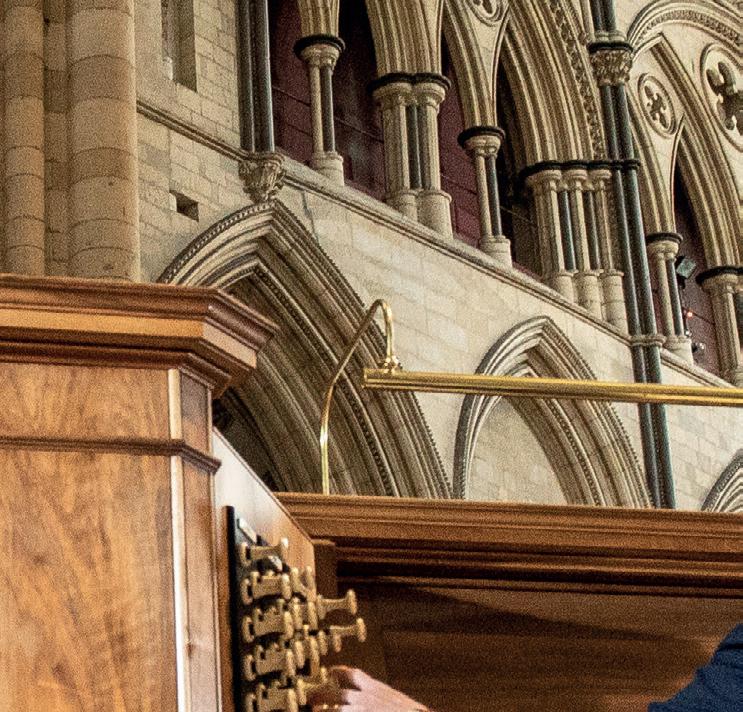

Peter Eddy
Vivian Eddy
Colin Edwards
Philip Eisenbeiss
Shirley Ellis
Anthony Fage
Tim Fairbairn
Dr Robin Field
David Fishwick
Bruce Fletcher
Giles Fletcher
Professor Brian Foster
Jonathan Gainey-Brown
Andrew Gardner
Jonathan Gibbs
Martin Graham
Harry Grayson
Helen Greig
Catrin Griffiths
Clarendon and Rodney
Gritten
Michael Guest
David Haigh
Martin Haldane
Nicholas Hale
Michael Hall
Muriel Hamilton-Glover
Jacqueline Harkin
Philip Harman
Kent Harries
Cynthia and Gerald Harris
Robert Harris
Clare Heath
Gerald Heather
Brenda Heaton
John Higgins
Peter Higgins
Dr David Hiley and Deidre
Sellars
Dr and Mrs Hill MBE
Jennifer Hodghton
Diana Hodgson
Patrick Hodson
John Hogan
Denise and Michael Hopkins
Anthony Hopkinson
Dr Don Horisberger
Mark Horsley
Dr Robert Horton
Nicholas Houghton
Patsy Huddy
Michael, Elizabeth and Simon
Hughes
Josephine Humphries
Janet Hunt
Robert Inches

If

Robin James
Dr and Mrs Jarvis
Isabel and Patrick Jeffers
Mark Johnson
Peter Johnson
Graham Jones
Michael Jones
Robert Jones
Christopher Joseph
Michel Kallipetis
Robin Kellow
Diana Kendrick
Sally Kentfield
Professor David Kimbell
Dr Christopher Kimberley
Adam King
Margaret Kingman
Anna Kingsmill-Vellacott
Rosemary Kirkman
John Kirvan
Perry Kitchen
Dr Robert Knowles
Stuart Laing
Leonard Lamb
Stephen Lamont
Scirard Lancelyn Green
Susan Lane
Keith Lane
Edith Laprun
The Very Revd Jonathan Lean
Claude Lee
Robin Lewington
Richard Line
Sarah and Timothy Ling
Richard Link
Raymund Livesey
Keith Long
Pippa Lovering
Beryl Lowe
Crista Lyon
Dr Douglas MacDonald
Joe Mace
Andrew Maddocks
Sarah and Richard Malins
Gillian Mapley
Richard Marshall
Gill Mason
Alan Mathewson
Michael Matthews
Anthony McClaran
Martyn McClelland
Anne McDonald
Neil Medland
Revd Gordon Melvin
Andrew Menzies
Colin Menzies

Andrew Millinchip
Michael Minta
Stephen Mollett
Mark Molony
David Monger
Stephen Montgomery
Nicolas Moodie
Christopher Moore
Linda Moore
Heather Morgan
Margaret Morris
David Moss
Revd Canon James Mustard
Penelope Naylor
Jill Neal
Dr Martin Neary
Revd Kimonie Nicholls
Dulcie Noble
Timothy Noon
Brian Ollett
Joan Orton
Revd Canon Keith Pagan
Susan and Frank Paice
Bruce Parker
Revd Denis Parry
Jean Partington
Patricia Paul
Brian Pearson
Dr Anne Peebles Brown
Revd Canon Jeremy
Pemberton
Roger Pengelly
Narayana Picton
Judith Power
Philip Price
Sue Prickett
Ian Provost
Brigadier Neville Pughe
Jennifer Railton
The Ven John Rawlings
Jane Regan
Revd Canon John Rendall
Andrew Revans
Giles Richards
Neville Richards
Dame Patricia Routledge DBE
Nigel Salisbury
David Salter
Hilda Scarth
Clare Scott
Richard Seaton
Carol Seymour-Newton
Keith Simpson
Andrew Sims
Isobel Skelhorn
Doreen Sladdin
Thirza Sloan
Dr Peter Smail
Alexander Smith
The Rt Revd and Mrs Stancliffe
John Stanley
Martin Stanley
Margaret Stephen
Anthony Stone
Richard Tanner
Revd Father John Thackray
Ian Thompson
Margaret Thompson
Michael Thompson
John Thorne
Graham Thorpe
Clive Tibbits
Janet and David Tiley
Louise Topping
Dr Bernard Trafford
Monica Trenchard
Adam Tunnicliffe
John Turner
Gordon Tyerman
Peter van Son
Tom Venner
Mark Venning
Margaret and Richard Vincent
David Walde
Catherine and Nicholas
Walker
Colin Walker
Amelia and Henry Wallace
John Wallace
Susan and Clive Watkis
Dr and Mrs Watts
Eric Wayman
Ian Westley
Irene White
Revd Dr Rowan Williams
Dr Roger Williams
Susie Williams
Margaret and David Williamson
Arnold Wills
David Wilson
John Winpenny
Nigel Wissett-Warner
Professor Martin Woodward
Dr and Mrs Wooldridge
Diana Woolley
Christine Wright
Käthe Wright Kaufman
Janet Yerbury
And several anonymous
Patrons and Friends



Alexandra
Catherine Groom
Rupert Gough
Bret Johnson
Geraint Lewis
Brian Morton
David Ponsford
Philip Reed
Michael Quinn
Clare Stevens
Rebecca Tavener
David Vickers
L’Orgue Grégorien
Ben Bloor, organ by J W Walker & Sons (1952), in the London Oratory Ad Fontes AF011
This is a remarkable recording of a whole liturgical year of plainchantbased organ music composed within the last 100 years or so. The organ, originally designed in the early 1950s to bring ‘classical’ organ building principles to Great Britain, has turned out to be, in my opinion, the best eclectic organ in the country: a wonderfully varied specification, with each register (and combinations) designed to speak strongly in this building of splendid acoustical properties. Ben Bloor, as the resident Oratory organist, is evidently at home with every aspect of the instrument, and, being steeped in Gregorian chant, he is the ideal person to make this recording.
A history of keyboard music based on plainchant would be an enormous undertaking, and Bloor has sensibly restricted himself to the last century. However, the enormous variety of forms, harmonic styles and compositional imagination recorded here is inspirational – a model for composers and improvisers alike. English works are represented by the Carillon on ‘Orientis Partibus’ by Arthur Wills, a French toccata in Wills’s own style of pan-tonality and asymmetric metres; Ralph Downes’s ‘Paraphrase on O filii et filiae’; and a specially-commissioned work by Mathew Martin, the Prelude on ‘Conditor alme siderum’. Two
movements from Karg-Elert’s Cathedral Windows (Op 106) demonstrate his German lateRomantic kaleidoscopic harmonic style, in which Bloor projects the enormous variety of tone colours and power-levels of the Oratory organ. As expected, French composers feature most: Naji Hakim’s short Antienne, Duruflé’s variations on Veni creator, Alain’s variations on Lucis creator and Postlude pour l’office de complies, Tournemire’s Diptyque (L’Orgue Mystique No 11), Daniel-Lesur’s In paradisum, Jeanne Demessieux’s Rorate Caeli, and Auguste Fauchard’s Le mystère de Noël – a work which deserves to be much better known.
The booklet is beautifully presented, and the CD is excellently recorded. Very highly recommended.
DAVID PONSFORD*
Holst: The Planets arr for organ
Salisbury Cathedral Choir, John Challenger (org)
Salisbury Cathedral
SalscathPlanetsCD2024
This outstanding dual video and audio recording of Gustav Holst’s iconic The Planets, newly arranged and brilliantly performed by John Challenger on Salisbury’s magnificent Father Willis organ, is a major output of a collaborative music-in-schools education project involving Challenger, the cathedral, and charity La Folia.
Challenger’s performance is thrillingly energetic, supple and sensitive, playful, and wonderfully paced especially for the space.
Registrations are expertly judged, whether in excellently managed crescendos and diminuendos, subtly layering shifting textures, or deploying a kaleidoscope of individual colours and balanced contrasting combinations, negotiating well when to replicate or translate orchestral colour in(to) organ colour.
The higher-resolution sound of the audio-only version is ideal for audiophiles and eyes-closed listening, with extremes of dynamic and pitch clearly rendered, and presence and sense of space well balanced. But these sonic attributes are still very good on the film in 4K, especially with quality headphones or speakers, so – some frustrating free-YouTube ad interruptions aside – the film presents the fullest, most immersive sensory experience to engage both those well-acquainted with, and those discovering, the music and the organ.
MATTHEW BLAIDEN*
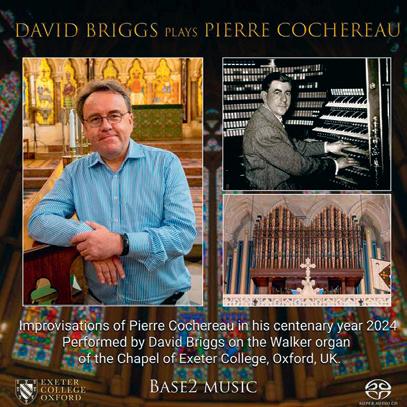
David Briggs plays Pierre Cochereau
David Briggs, Walker organ (1994), Exeter College, Oxford Base2 Music-013
Transcribing the improvisations of Cochereau has been a labour of love for Briggs since the earliest days of his career. To mark Cochereau’s centenary in 2024, Briggs shares a number of wonderful transcriptions (and the Suite Française made by Jeanne Joulain). The Exeter College organ, the first attempt to build a 19th-century French style organ in
an Oxbridge Chapel, sounds glorious; different from Notre-Dame in the 1970s, of course, yet surely Cochereau would have relished this instrument; and one gets to hear a lot more detail of the intricate textures. From such a small twomanual instrument, Briggs captures all the magical sounds one associates with the most famous organ improviser the world has known.
RUPERT GOUGH*
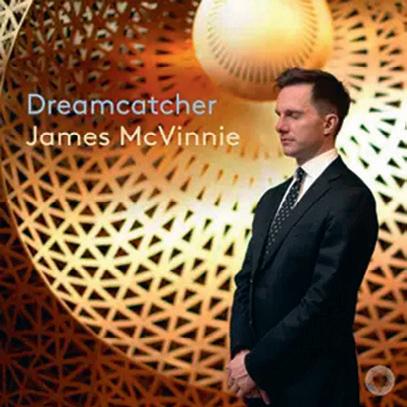
James McVinnie, Harrison & Harrison, St Alban’s Cathedral, UK
Pentatone PTC 5187404
McVinnie’s reputation for bold, imaginative programming is borne out in this compilation alternating
contemporary works for organ with some for piano. This thoughtprovoking world we enter at McVinnie’s hands leaves us full of imaginings as well as contemplating current issues; the title track by Marcos Balter is a piano piece in response to the child-separation crisis at the US-Mexico border. More familiar works like Giles Swayne’s Riff-raff and John Adam’s China Gates sit alongside inventive and imaginative works by Nico Muhly, Meredith Monk and others. Across the whole disc, McVinnie displays remarkable rhythmical dexterity and control, allowing us to enjoy trancelike luminosity from minimalistic textures.
RUPERT GOUGH*
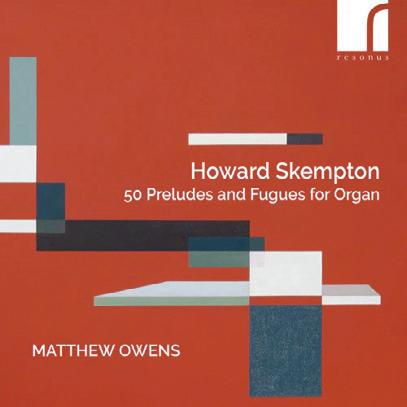
Howard Skempton: 50 Preludes and Fugues for Organ
Matthew Owens (org)
Resonus Classics RES 10336 (2 CDs) Howard Skempton (b 1947) here mirrors Bach’s Well-Tempered Clavier in its exploration of all the major and minor keys. Many of them are, however, more contemplative than contrapuntal with slower moving textures. They are often very short and appear more like epigrammatic sketches rather than concerted ‘etudes’. That is not to say they lack variety and contrast (No 11, for example, is an exquisite carillon pursued by the briefest of fugues) and 13 is a short but fierce cascade with a majestic passacaglia-like sequel. There are other animated episodes too amidst these thoughtful impressions. In 20, a chorale-like figure yields to a fugue which (like so many of them) never finishes, leaving you wondering as to what might have been. Skempton himself believes that conversations suddenly suspended in this way open up new musical questions and ‘shine a light in

another direction’. The unfinished thumbprint, ingenious as an idea, may lose its impact if repeated too often. The 50 Preludes and Fugues are responses in miniature to the ‘48’ rather than full answers. The other eight pieces included on this double album are in similar vein, although the Passacaglia and the Organ Postlude spread their wings more. These short, largely calm and reflective pieces are played and recorded with great clarity on the same very fine instruments on which Matthew Owens premiered the Preludes and Fugues.
BRET JOHNSON
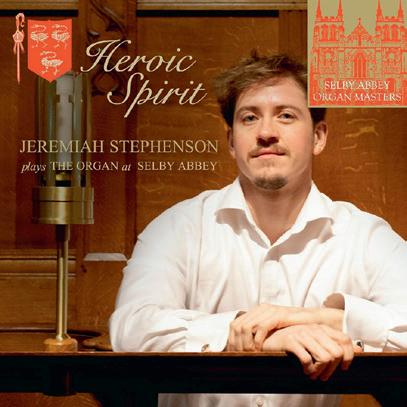
Jeremiah Stephenson (org) Selby Abbey Organ Masters SAOM017
Canadian Rachel Laurin, who died, aged 62 in 2023, is the odd woman out in this debut recital by Jeremiah Stephenson from Selby Abbey Organ Masters.
Her Étude Héroïque all but steals the show as it sets the scene for Franck’s Fantaisie in A, Duruflé’s Prelude, Adagio et Choral variations on Veni Creator, Tournemire’s Deuxième Fresque Symphonique and miniatures by Widor, Vierne and Dupré.
Stephenson laces all with the individuality of emotion and expression they are due, particularly adept at colouring chiaroscuro contrasts, alert to, and daring in his use of, dynamics.
Bookended by Laurin’s variegated epic-in-miniature and the finale to Dupré’s Evocation, he makes articulate use of Selby Abbey’s wholly conducive and eloquent IV/67 Hill organ.
MICHAEL QUINN*
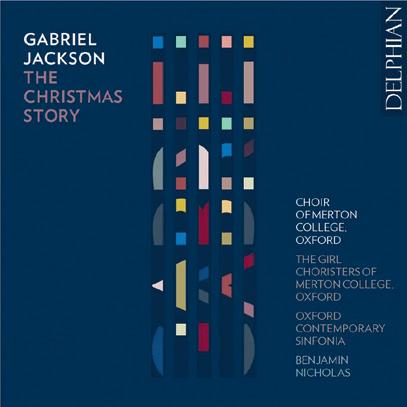
Girl Choristers and Choir of Merton College, Oxford; Oxford Contemporary Sinfonia / Benjamin Nicholas with Owen Chan, François Cloete org Delphian DCD34331
A decade on, and Gabriel Jackson’s award-winning collaboration with Benjamin Nicholas and the Choir of Merton College, Oxford, The Passion of Our Lord Jesus Christ, gets a major follow-up.
Premiered last year and now recorded for the first time, The Christmas Story also reunites Jackson with Simon Jones, who once again collates the patchwork libretto for this large-scale choral project.
Christmas may be the headline here but it forms only one panel of four – each a meditative sequence of motets, antiphons, responsories and Gospel settings – that take us from Advent right through to Candlemas. Jones shapes and paces his drama astutely, zooming in on the human – a lurching dance at the Cana wedding, the musings of the pregnant Mary, the ‘bit and plough’ hanging ready for the working day in the Bethlehem stable – while also panning out to the mystical, combining the narrative of the Gospels with contemplation, firstperson episodes in contemporary verse with Latin liturgical texts. Musically, there’s a strong relationship with Jackson’s Passion The alto saxophone is back, an arresting solo voice, nodding as much to shofars as shawms and trumpets – a bit ancient and a lot modern, especially when framed by the other musicians of the 12-strong Oxford Contemporary Sinfonia.
Merton’s excellent Girl Choristers, bright and focused, diction immaculate, supply the oratorio’s chorale-like moments of pause: a series of motets for unison voices and organ setting the words of Merton-affiliated contemporary poets Penny Boxall and Mary Anne Clarke. There’s often a strangeness to The Christmas Story – of instrumentation, style, text – that helps refocus the ear on a story blurred by over-familiarity. It’s another appealing and viably enduring contribution to the repertoire from an institution putting its commissioning money where its mouth is when it comes to the choral tradition.
ALEXANDRA COGHLAN**
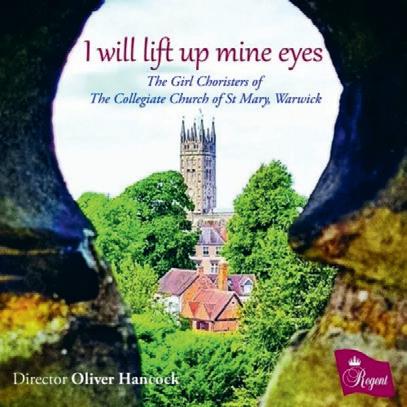
I will lift up mine eyes
Girl Choristers of the Collegiate Church of St Mary’s, Warwick Mark Swinton, Colin Millington (org) / Oliver Hancock (dir) Regent REGCD583
Listening to 21 brief anthems for upper voices one after the other might not be everyone’s favourite way to spend an hour, but my goodness these girls melted my heart with their programme of music from many centuries, including works by six living composers.
Malcolm Archer, whose touching setting of ‘My song is love unknown’ opens the album; Paul Bryan (an attractive set of anthems written for the chapel choir of St John’s College School Cambridge); Sarah MacDonald (whose haunting, insistent Miserere mei provides a touch of salt just when you need it); Paul Edwards; Mark Blatchly; and Simon Lole (his first published work, ‘The Father’s Love’, written for the wedding of a former member of Croydon Minster’s Girls’ Choir). ▷
Many old favourites are here, from Hildegarde’s O virtus Sapientiae through Dering’s Duo Seraphim and Parry’s ‘Long since in Egypt’s Plenteous Land’ to Peter Hurford’s ‘Litany to the Holy Spirit’ with a descant by the choir’s director. Stand-outs for me: a lovely performance of the first movement of Pergolesi’s Stabat Mater, with exquisitely delicate chamber organ accompaniment by Mark Swinton; Sir John Dankworth’s jazz-infused ‘Light beyond shadow’; the title track, a setting of Psalm 121 by Colin Mawby that was new to me; and the beautifully phrased and balanced Lole piece. Occasional phrases are slightly oversung and there are one or two abrupt gear changes, but that’s surely a sign of the girls’ love and enthusiasm for the music, which shines through every bar.
CLARE STEVENS
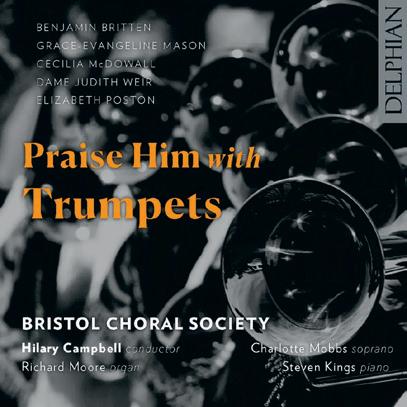
Bristol Choral Society, Charlotte Mobbs (s), Jo Harris, Neil Brough (tpts), Evva Mizerska (cello), Steven Kings (pno), Richard Moore (org) / Hilary Campbell (dir) Delphian DCD34340
The substantial forces of Bristol Choral Society (BCS) stamp their authority on this interesting and demanding programme from the outset, with a very fine performance of Britten’s Rejoice in the Lamb, featuring accomplished step-out soloists from the choir and lots of contrasts in tone and volume. The team deserve great credit for finally bringing their second recording project to fruition, as Covid-19 wreaked havoc with director Hilary Campbell’s careful plans, but it was well worth the effort. Shakespeare settings by Vaughan Williams, Elizabeth
Maconchy and Cecilia McDowall, featuring soprano soloist Charlotte Mobbs, and Holst’s setting of Psalm CXVIII, complement three premiere recordings. Judith Weir’s ‘Praise Him with Trumpets’ was written for the quincentenary of Hampton Court Palace and is appropriately jubilant.
BCS gave the first performance of Grace-Evangeline Mason’s atmospheric A Memory of the Ocean, commissioned by the Royal Philharmonic Society with support from the Vaughan Williams Foundation to mark RVW’s 150th anniversary year, and they relish its elemental drama. The programme concludes with Elizabeth Poston’s Festal Te Deum, commissioned for the patronal festival of St Matthew’s Northampton in 1959, linking back to the Britten, which marked the same occasion at St Matthew’s in 1943. Recording this piece was a real ‘passion project’ for Campbell, and her choir produces a thrilling sound in the chapel of Bristol’s Clifton College.
CLARE STEVENS*
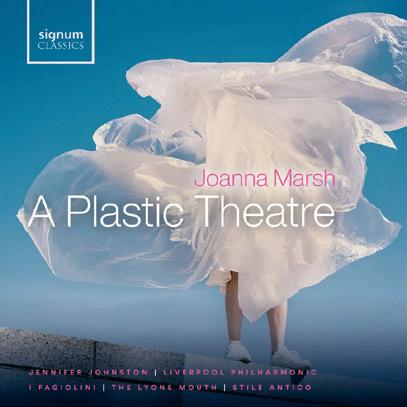
A Plastic Theatre – Joanna Marsh
I Fagiolini / Jennifer Johnston (mezzo-soprano) / The Lyons Mouth / Stile Antico / Royal Liverpool Philharmonic Orchestra & Youth Choirs
Signum SIGCD929
If you don’t already know the wonderful choral works of Joanna Marsh, this portrait programme makes an ideal introduction. Ranging in scale from vocal trio to orchestra and choir, her colourfully compelling sonic palette, deeply emotional and sensitive to layers of meaning, and her technical sureness of touch shines from 11 works, performed by the top-notch ensembles that
commissioned and/or premiered them. Settings of diverse texts, including John Donne, E E
Cummings, Julian of Norwich, and Katie Schaag, whose multimovement A Plastic Theatre resonates both philosophically and musically, reveal Marsh as a credible and versatile voice for our times.
REBECCA TAVENER*
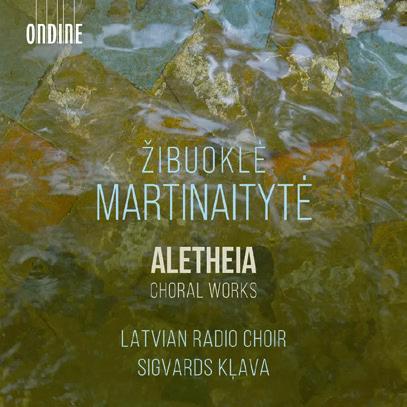
Žibuoklė Martinaitytė Aletheia
Latvian Radio Choir/Sigvards Klava (dir)
Ondine ODE1447-2
Lithuanian by formation, but based in New York, Žibuoklė Martinaitytė creates music that feels, in that overused term, genuinely immersive. Aletheia was composed just as Russian troops were entering Ukraine and the wordless choral score is invested with equal parts of foreboding and fragile hope. This has turned to sorrow by the time of Ululations, written the following year, and inspired by the parallels between owls calling in the night forest and women weeping aloud for their dead. In between, and wisely, the more abstract Chant de voyelles, literally ‘song of the vowels’: also wordless, also partly ululated, equally haunted and haunting. Superbly controlled singing under Kļava, as ever, with a woodwind-like clarity of sound.
BRIAN MORTON*
Robert Fayrfax: Maria Plena
Virtute
The Tallis Scholars / Peter Phillips
Gimell CDGIM054
Just four works make up the Tallis Scholars’ latest recording: four of Robert Fayrfax’s mighty votive antiphons – Maria plena virtute, Ave Dei Patris, O Maria, Deo grata, Eterne laudis lilium – each a 15-minute affair of cathedral-like scope and proportion.
It is the first time Peter Phillips and his ensemble have turned their attention to the English composer and Phillips prefaces his recording with a disclaimer: anyone arriving at this music expecting the Fayrfax of the Eton
Choirbook will be disappointed. In place of the intricate vocal lines, endlessly embellishing simple harmonic architecture, we get music that’s altogether leaner, more emotionally and melodically direct. Just 10 singers dispatch these five-voice works, supplying both the agility of solo versesections and the warmth and weight of tutti passages. If the former are sometimes more satisfying, the overall effect is pellucid, allowing plenty of light into Fayrfax’s airy, wide-spaced textures.
If the most immediately gratifying work here is the (probably earlier) Eterne laudis lilium, with its
greater melismatic indulgence and luscious imitative Amen, the sonic drama is at its most intense in the mature Maria plena virtute (surviving only in three parts, with treble and tenor reconstructed by Nick Sandon), posited by Phillips as the climax of a career’s experience. The anonymous text – a vivid account of the Crucifixion, followed by a prayer to the Virgin – is set starkly. Textures are often reduced, and while the trebles retain their lofty distance, it’s the lower voices that dominate, wrestling over Christ’s suffering with crisp rhythmic convulsions and imitative back-and-forth. It’s powerful stuff – all the more so for ▷
its refusal to soften the edges of this brutally beautiful music.
ALEXANDRA COGHLAN*
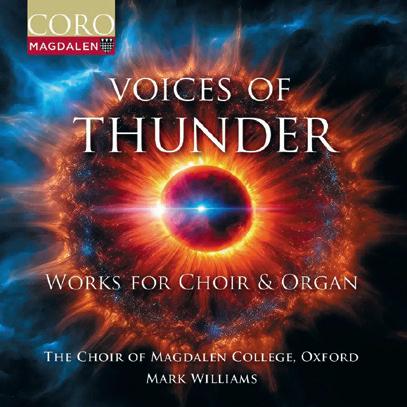
Romain Bornes, Edward Byrne, Alexander Pott (org), Eule organ (2023), Magdalen College Chapel, Choir of Magdalen College, Oxford/ Mark Williams (dir)
Coro COR16209
A debut on disc for Eule’s first UK organ makes its own claim for attention, deftly accompanying characterful, beautifully rounded singing by Magdalen College’s choir. The IV/45 Eule’s German romantic accent suits the wide-ranging programme. There’s a magical quality to Dove’s ‘Seek him that maketh the seven stars’, magnificent eloquence in Balfour’s Evening Hymn, and colour aplenty in Malcolm Boyle’s ‘Thou, O God, art praised in Zion’. Contemporary pieces by MacMillan, Tabakova, Weir, Larsen and Pärt (The Beatitudes bursting out of simple homophony into a blaze of organ arpeggios) sit comfortably alongside Haydn’s virtuosic summoning of a storm (Insane et vanae curae),
Stanford’s ‘For lo, I raise up’ and Parry’s unabashed blending of Wagner and Brahms, Blest Pair of Sirens
MICHAEL QUINN*
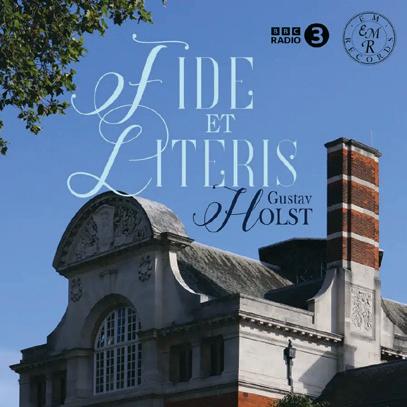
Holst: Fide et Literis Em Marshall-Luck (reciter), Paulina Voices, BBC Concert Orchestra / Leigh O’Hara (dir)
EM Records EMR CD090

The 150th anniversary of Holst’s birth last year was a good enough reason for this unusual recording that celebrates the composer’s close association with St Paul’s Girls' School in West London. Holst served as director of music there from 1905 until 1934, and it was there that he wrote part of The Planets, and also the St Paul’s Suite and Brook Green Suite
Both the latter works are included on this interesting CD, where they receive thoroughly respectable accounts under Leigh O’Hara, himself a former director of music at the school. But the CD’s interest for the dedicated Holstian must surely lie in the premiere recordings of the remaining works on the programme.
The Gavotte of 1933 is a casualty from the Brook Green Suite, removed by the composer after hearing a rehearsal in 1934. More substantial is the Seven Choruses from the Alcestis of Euripides (1920), and the masque entitled The Vision of Dame Christian (1909), both essentially music for dramatic texts, along with Playground Song (1911).
While none of them is Holst at his finest, they each demonstrate his ability to deliver well-crafted occasional music. The entire programme – familiar and unfamiliar – is prepared with dedication, with the school’s Paulina Voices making a distinguished contribution.
PHILIP REED*
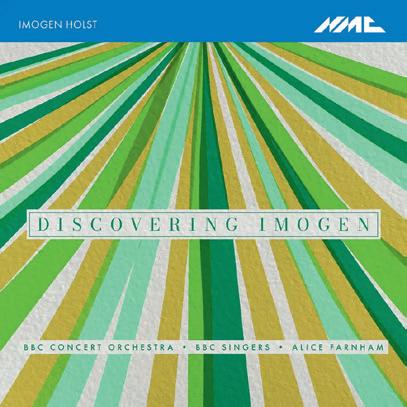
Imogen Holst: Discovering Imogen
BBC Singers, BBC Concert Orchestra/Alice Farnham (dir)
NMC D280
Musical riches are being revealed as Imogen Holst’s extensive catalogue is explored by researchers, including many substantial compositions that
received only one performance or even remained unperformed in her lifetime, largely due to her extraordinary reticence about her own work, and reluctance to talk about let alone promote it. A particular gem is Persephone, the powerful, imaginative symphonic poem that opens the recording, written while she was still a student and reminiscent of Bax or Harty in its dramatic colour.
‘Probably 1940s’ is scribbled on the score of ‘What man is he?’, a setting of words from the Book of Wisdom, their introspective, troubled mood matched by a melancholy tread of falling scales in the orchestral bass, a striking climax on ‘the earthly frame weigheth down the mind’ where the harmony seems knotted and the music suspended in time before the final section proceeds to an unexpectedly jubilant conclusion. The concluding Festival Anthem, setting Psalm 104, is effectively a 15-minute-long cantata for mixed voices and organ, full of drama and eloquence.
CLARE STEVENS*
& asymmetry
Helsinki Chamber Choir/ Nils Schweckendiek (dir) BIS BIS2692
At the heart of this disc is the title work by Kalevi Aho (b 1949), an intense sequence of complex settings of poems by the Finnish poet Mirkka Rekola (1931-2014) that elide into one another, full of vivid imagery that is represented by sinuous musical lines. The programme is book-ended by works by Aho’s teacher Einojuhani Rautavaara (1928-2016): his haunting setting of Rilke’s Die erste Elegie, and the 20-minute sequence of texts by
various writers, Eläman kirja/A Book of Life. It also includes a beautiful set of choral love songs with texts by Rautavaara’s exact contemporary and friend Lassi Nummi (1928-2012); his Ave Maria of 1957 that demonstrates his fondness for lacing 12-tone rows with tonal elements; and three highly expressive settings by Aho, in Finnish, of poems by the 11thcentury Persian poet Mawlana Rumi. They were originally requested by a church choir in Helsinki but proved too demanding, so were premiered in 2010 by the Helsinki Chamber Choir, whose virtuosity is evident throughout this atmospheric recording.
CLARE STEVENS*

News of Great Joy: Christmas from St John’s College, Oxford
The Choir of St John’s College, Oxford, Christian Wilson (org)/ David Bannister (dir) Resonus RES10348
To make one’s mark in in the overcrowded Christmas music market a canny angle helps, and the 60th anniversary of the Penguin Book of Carols, compiled by Elizabeth Poston with the blessing of Ralph Vaughan Williams as a revision of the 1928 Oxford Book of Carols, has inspired this excellent programme. Gustav and Imogen Holst, Vaughan William, Warlock, Britten, Maconchy and Poston herself all feature, as do more recent composers such as Stopford, Rutter, Chilcott and Bednall, in sensitively chosen works with barely a hint of seasonal schmaltz. The upper voices shine in Britten’s Corpus Christi Carol, the medieval Song of the Nuns of Chester, and Bednall’s exquisite Ave Maria Poston’s celebrated Jesus Christ the Apple Tree suffers from an inbuilt choppiness from which choirs
struggle to produce truly legato lines, and Richard Rodney Bennet’s deeply mystical Puer nobis (a personal favourite) here lacks the spaciousness it needs, not helped by over-produced consonants. Mostly, however, the well-balanced and thoughtfully directed choir, technical and (minor) intonation issues aside, sings with affection, shapeliness, enthusiasm and a lively blend of interesting vocal grain. Undoubtedly a recording worth adding to your Christmas library, this intelligent selection lives up to Poston’s dictum that ‘it is significant that a handful only of composed carols or carol arrangements of the past fifty years stands out as of unquestionable worth… The ‘olde’, the counterfeit, the dreadful well-meant diminutives have no place alongside the eternal verities’.
REBECCA TAVENER

Britten: A Ceremony of Carols Choristers of Wells Cathedral, Olivia Jageurs (harp)/ Alexander Hamilton (dir)
YouTube
Benjamin Britten mixed the most delicious Christmas cocktail in his Ceremony of Carols, with perfectly judged measures of youth, medieval texts, faith, mystery, and the archetypal instrument of heaven, the harp. The boy and girl choristers of Wells Cathedral here sing together from memory, by heart and clearly from the heart, enabling their full concentration on the physicality of voice production and the meaning of the texts. Their healthy, relaxed, well-rehearsed and supremely fresh singing is sheer joy and Alexander Hamilton draws lovely phrasing and intense concentration from his talented choir.
Both full ensemble and soloists sing with elegant musicality and superb intonation, rising to Britten’s challenges with aplomb. Excellent harpist Olivia Jageurs channels the ‘magnitude and melody’ invoked in another famous Britten work, though a little more harp in the balance would not have gone amiss in such a lively acoustic and with such wonderfully ‘out there’ singing.
The sound recording is rich with presence and the film is visually stunning, from the procession through an unlit nave onwards, with imaginative camera angles. The visuals appear to show a live performance (in a cathedral empty of visitors) rather than miming to playback, and the coordination with the edited sound recording is remarkably exact.
Britten’s musical mixology offers such excellently trained young voices a life-enhancing opportunity to be part of a numinous alchemy of music and architecture - there could hardly be a better advertisement for becoming a chorister.
REBECCA TAVENER

Choir of Christ’s College, Cambridge, Julian Collings (org) /David Rowland (dir)
REGENT REGCD580
This CD will come as something of a delightful surprise for any purchasers expecting the rather intimate sound of the 20 or so voices of the current Christ’s College, Cambridge choir. Not a bit of it – we have a glorious celebration of Professor David Rowland’s remarkable 40 years as Director of Music at the college, with over 80 chapel choir alumni also invited back to join in, making more than 100 voices on some tracks. What
a feat of organisation and, in the generous acoustic of St Michael, Cornhill in the City of London, with its eminently suitable organ for this repertoire (Julian Collings - very good throughout) what a terrific sound!
All the Parry favourites are present and correct: the title track (of course) including the ‘Vivats’ as heard at the recent Coronation, Blest Pair of Sirens, Hear My Words Ye People, Songs of Farewell, and Jerusalem. The only less well-known offering is the charming part-song Music When Soft Voices Die, which is very sensitively sung. It is a shame perhaps not to include a few more relatively obscure works, but I suppose popular favourites had to be the order of the day when assembling such large forces, with (presumably) relatively little rehearsal time.
The six unaccompanied Songs of Farewell, sung by a slightly smaller group, are a real highlight, with good attention to detail and a nice, blended sound. Hear My Words, Ye People (ending with O Praise Ye the Lord, of course) is well done, though it is perhaps disappointing not to include the specified solo quartet or a small semi-chorus in two later sections (Behold the Eye of the Lord, and The Lord is Full of Compassion) for added contrast. Overall, a very worthwhile venture and a suitably festive celebration of Prof Rowland’s long tenure at Christ’s. Recommended.
MARK BELLIS
A Year at Newcastle Choir of Newcastle Cathedral / Ian Roberts (dir)
REGENT REGCD582 and
A Year at St Edmundsbury Choir of St Edmundsbury Cathedral / Timothy Parsons (dir)
REGENT REGCD591

There is much to enjoy here from two choirs clearly on very good form at the moment. There are substantial favourites: from Newcastle, Ian Roberts’s well-sustained direction of Finzi’s Lo, the Full Final Sacrifice, and commendably, both discs include a good number of new commissions and first recordings. On the Newcastle disc, I enjoyed Alan Gray’s Three Grace Anthems, recently rediscovered and edited by one of the choir’s basses, Matthew McCullough, and music well worth reviving. The choir’s Assistant Director of Music, Kris Thomsett (also the reliable organist on this disc) contributes an effective unaccompanied setting of Ubi Caritas - a daring choice of text perhaps given the classic settings we all know, but by no means overshadowed by them - and it receives a committed performance. Also unaccompanied is the Wells Service by William Drakett (a bass
Vicar Choral in Wells cathedral choir) which has a pleasant, plainsongbased style and is lyrically sung. And it is nice to hear Bairstow’s rather rarely done Easter anthem Sing Ye to the Lord - here, suitably festive. One minor irritation: the strict ‘church year’ concept does lead to some works being broken up by other tracks and not running consecutively - e.g. the Mag and Nunc, and the three Gray anthems - though I suppose one could programme the tracks to play in the ‘correct’ order. In all, this certainly whets one’s appetite for Cathedral Music Trust’s National Gathering later this month.
From St Edmundsbury, we have, if anything, even more enterprising repertoire, including new commissions from Edward PictonTurbervill and Ghislaine Reece-Trapp - the latter (Epiphany Star) particularly atmospheric and musically done. There are some lovely performances: Sally Beamish’s
disarmingly simple In the Stillness (from Choirbook for the Queen) is beautifully controlled and Bairstow’s Let All Mortal Flesh Keep Silence also illustrates the choir’s nicely blended tone. The rousing finale is James MacMillan’s A New Song - very well negotiated. The highlight of the disc or me however was a stunning harvest-tide anthem from the Director of Music at St Edmundsbury himself, Timothy Parsons: The Spacious Firmament on High, with remarkably inventive scoring and textures for both organ (the excellent Richard Cook) and choir, who rise brilliantly to its not inconsiderable challenges. Timothy took up his post as Director of Music at Wells Cathedral in September 2024 where, with its well-known commitment to new music and commissions, he should feel very much at home, on this evidence.
MARK BELLIS
Wisdom & Strength: Contemporary Sacred Choral Music
Siglo de Oro, Simon Hogan (org) / Patrick Allies (dir) Delphian DCD34337
This album belongs to that interesting genus of recordings in which liturgy and sacred music are brought together to recreate a particular service or feast day. Siglo de Oro and director Patrick Allies here recreate a scheme of Sunday worship with works by contemporary composers, extending the concept to encompass key points of the church calendar.
Proceedings begin with two motets for Compline: Kerensa Briggs’s multi-voiced Media vita, commissioned by Siglo de Oro in 2015 to mark the 500th anniversary of John Sheppard, and Judith Ward’s Sarum responsory In manus tuas, steeped in chant and modal colour. Ward’s Mass for St Mark forms the core of the Eucharist (minus the Credo): finely crafted, liturgically practical music, especially the Kyrie and Agnus Dei. Its not unduly technically challenging harmonic palette is deftly designed to be accessible to both professionals and accomplished amateurs. Between movements come Sarah Cattley’s fanfare-like Haec dies, Joanna Marsh’s double-choir Worthy is the Lamb, and Kristina Arakelyan’s expressive communion motet Christ, our Paschal Lamb. Ward’s lively O clap your hands rounds off the first half as a choral voluntary. The second half turns to Choral Evensong. Marisse Cato’s Flamed Tongue is a vivid Pentecost introit, followed by Ward’s Responses and Psalm 59 in Shruthi Rajasekar’s astringent double chant. A text
characterised by its sense of hostility and violence, it finds an apt setting here. Alison Willis’s acappella Magnificat, written as a companion to Pärt’s Nunc dimittis, offers a meditative take on the Annunciation, paired here with Amy Summers’s contemplative Latin setting of the Nunc. After the final Responses, Kerry Andrew’s O lux beata Trinitas anthem combines ostinato, aleatoricism, and textural layering, and the programme ends with Ward’s organ toccata, Gloria tibi Trinitas.
An imaginative album, beautifully sung and directed. Credit, too, to organist Simon Hogan for his sensitive accompaniments and the final voluntary. Delphian’s warm recording, enhanced by Waltham Abbey’s acoustic, brings clarity and glow to these mostly premiere recordings.
JEREMY DIBBLE**

Heavenly Light
Selene
Daniel Gilchrist (dir)
CRD CRD3555
Of all the polyphonic repertoires that survive in fragmentary state, that of the famous Eton Choirbook is one of the most challenging to reconstruct. About a third of the manuscript is entirely lost, and fewer than a dozen antiphons can confidently be restored based on what remains. (How fragmentary a work must be for reconstruction to be considered overly hypothetical or even impossible is debatable in itself; the most credible candidates are those where half the work survives complete, leaving two or at most three voices to be supplied for the remainder, as with William Horwood’s Gaude virgo mater Christi.) The young Oxford-based
choir Selene presents several works in reconstructions by Russell Blacker. There is something indescribably touching about this aural glimpse into the unknowable, particularly as the Choirbook is practically the sole witness to the work of at least two generations’ worth of English polyphonists. Anyone who holds its music dear can only be intrigued at the results. But there are caveats, of which just a few can be touched on here. On the local level, one has the impression of familiarity, even of recognition; the contrapuntal detail bespeaks a knowledge of the style, but often as though a plausible phrase is in the wrong place or the wrong voice. Errors that Eton composers largely avoid (such as consecutives fifths or octaves) happen too often for comfort. More fundamentally, there must be doubt about some of the most basic decisions — for example, how many voices (if any) to add in any given section. (The opening of the second section of Davy’s Gaude flore virginali is a case in point: to the duo that survives and stands here on its own, at least one other voice is audibly required.) Finally, these young singers are not yet quite equal to the challenges of the music, in either technical security or ensemble. Perhaps the promised second volume will allow them to grow into the music
FABRICE FITCH

Anam
Apollo5 / Clare Stewart (sop) / Penny Appleyard (sop) / Oscar Golden-Lee (ten) / Gus Perkins Ray (bar) / Joseph Taylor (ten)
VOCES8 Records VCM165D
Apollo5’s seventh album, Anam (Old Irish for ‘soul’ or ‘spirit’, we learn in the booklet) brings together a range





















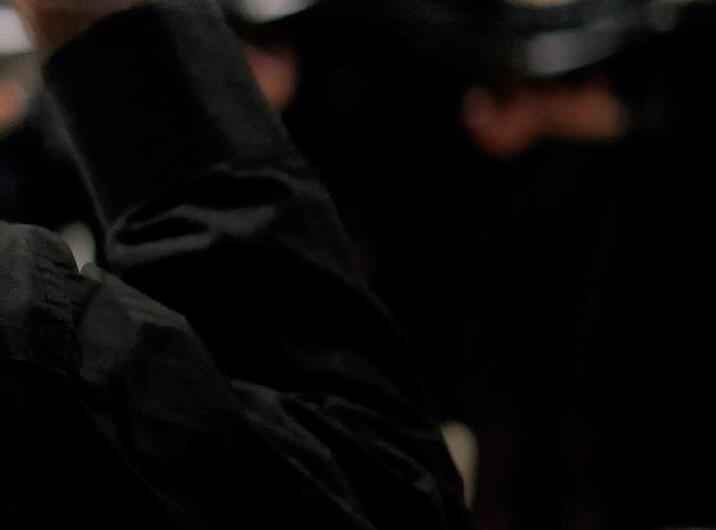
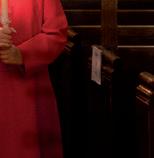

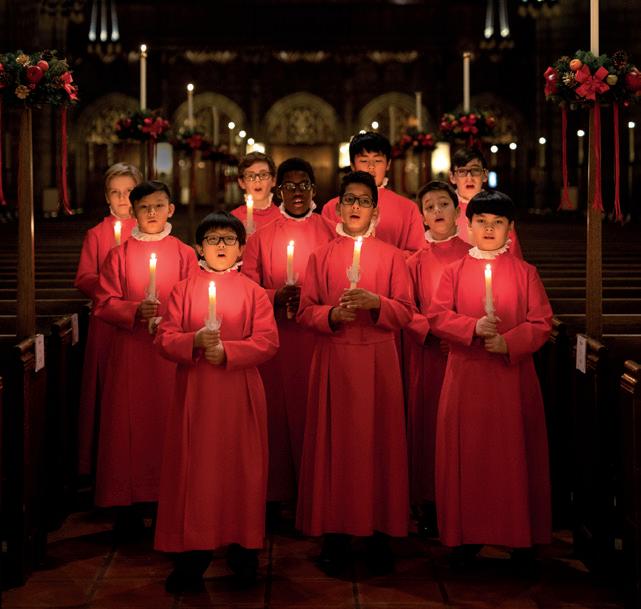




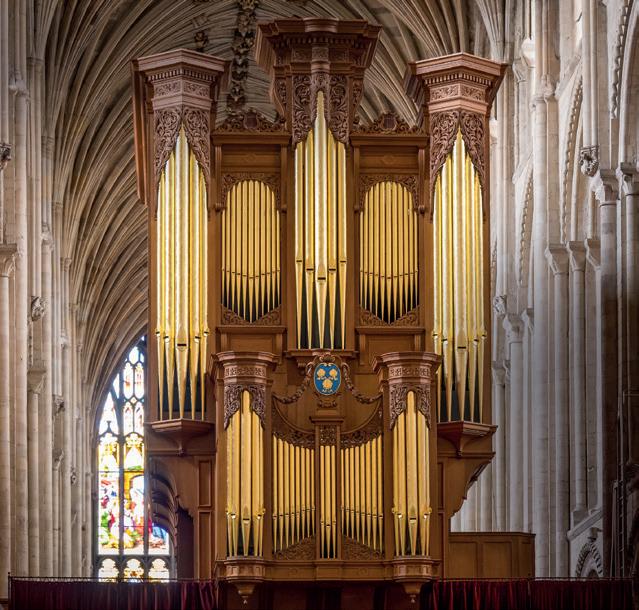




of Celtic influences – texts, songs, melodies, composers and arrangers – in a programme featuring many new commissions and arrangements, designed to move the soul. Overall, there is perhaps more soulful rapture and reflection than motion, with plenty of gorgeous melodies and sumptuous harmony, but with the most conspicuous rhythmic excitement only coming in items near the end. But throughout, Apollo5 displays again the beautiful singing and impressive ensemble – balance, clarity, togetherness – for which the group has come to be known.
My highlights included Rebecca Tavener’s striking monody ‘O Rubor’, with sighed glissandos, suggestive of gathering and dispersing energy, before/after the main chant that takes sinuous chromatic melismatic diversions on ‘fluxit’ and ‘serpentis’; Lucy Walker’s beautiful and rousing ‘My heart, my God, is steadfast’; the fresh suppleness and clarity achieved in Hubert Parry’s classic ‘My soul, there is a country’; and the two tracks (I’d have welcomed more) featuring collaborative instrumentalists, Ruth Wall (harp) in James Macmillan’s ‘Os Mutorum’, and Rita Farre (uilleann pipes) and Teena Lyle (percussion) in Lyle’s own ‘The Eternal Rose’. But across seventeen fairly short tracks, there’s lots to enjoy
MATTHEW BLAIDEN

Grace Williams: Missa Cambrensis
April Fredrick (sop) / Angharad Lyddon (mez)
Robert Murray (ten) / Paul Carey Jones (bass) / Dr Rowan Williams (narr) / Côr Heol y March/ BBC National Chorus and Orchestra of Wales / Adrian Partington Lyrita SRCD442
The Grace Williams revival continues
apace with this very significant premiere recording of her largest work for the concert hall. The Missa Cambrensis was composed between 1968 and 1971 and first performed at the Llandaff Festival that year to mark the composer’s 65th birthday. She was the doyenne of Welsh composers and regarded with unique respect and affection by musicians and audiences alike. This large-scale setting of the Mass was her most ambitious score to date and widely anticipated to be her magnum opus. In the event, the performance in Llandaff Cathedral was badly flawed (as the broadcast makes clear) and the score was never heard again until another BBC broadcast in 2016. The work’s closest British counterpart is the Missa Sabrinensis which Herbert Howells wrote for the 1954 Worcester Three Choirs Festival –another masterpiece replete with technical challenges. At the moment when Christ ‘was made man’ she introduces her own treble-voice Carol Nadolig (‘Christmas Carol’) from 1955. They are sung with compelling innocence by the Côr Heol y March from Bonvilston, near Cardiff in the Vale of Glamorgan, not far from the composer’s native Barry.
Williams was intrigued by the immediate proximity of Christ’s birth and death in the Nicene Creed (marking its 1700th anniversary this year) and so she dramatically separates them by inserting the essence of his teaching as recorded in the Beatitudes. These are spoken here by Dr Rowan Williams against a moving orchestral backdrop. Adrian Partington’s dedicated direction is clearly a labour of love and all who care about 20th-century British choral music should explore this enterprising Lyrita release.
GERAINT LEWIS **
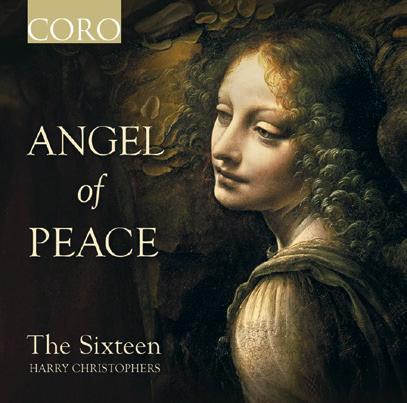
The Sixteen / Harry Christophers (dir) / Sarah Sexton (vln) Coro COR16210
At the heart of this album –designed to accompany The Sixteen’s 2025 Choral Pilgrimage –sits music by Arvo Pärt, who will celebrate his 90th birthday in September. Best known is the 1989 setting of the Magnificat in Latin, which is performed with great clarity and a proper sense of Marian devotion. Sadly, appropriate to our troubled times is the wonderful Da pacem Domine , composed for Jordi Savall in the wake of the 2004 Madrid train bombings and resonating with austere beauty and compassion. The intense care with which Pärt selects his notes is matched here to performances of perfect transparency and tonal balance. This 2025 programme divides into two halves with Hildegard of Bingen’s great Ave, generosa split to open each half providing an inimitable grounding of monody. Clyne’s setting of words by Rainer Maria Rilke blends neomedievalism with minimalism in a style that could sit easily as an evocative television soundtrack. Both works employ Sexton’s violin to telling effect, Todd as commentary and Clyne as accompaniment, and she plays with mesmerising individuality. The album’s two sections culminate in glorious votive antiphons by John Taverner that show The Sixteen at the top of their traditional game. Gaude plurimum flows with both ease and ecstasy, and demonstrates that miraculous blend of harmony emerging from counterpoint which makes this music such a feast for the senses. O splendor gloriae honours the Trinity and is well known for being – possibly – partly by Christopher Tye. Pilgrims should flock to any centre where this music is performed in 2025.
GERAINT LEWIS **

‘In Chains of Gold’
‘The English Pre-Restoration Verse Anthem, Vol 3: “Ah, his glory!” –Anthems of Praise, Prayer and Remembrance’
Magdalena Consort; Fretwork; His Majestys Sagbutts & Cornetts with Silas Wollston (org)
Signum SIGCD931
The third and final volume of ‘In Chains of Gold’ is devoted to Tomkins and his obscurer contemporaries. As in previous experiments reimagining English pre-Restoration verse anthems by Gibbons, Byrd, etc, the project’s mastermind William Hunt departs fundamentally from the beloved Anglican evensong tradition of collegiate and cathedral choirs, which has always necessitated upward transpositions and other awkward or implausible compromises. Accordingly, the
Magdalena Consort (between four and 14 singers) perform at historical high pitch (A=466) and have high tenors on the contratenor ‘alto’ lines. In a nutshell, the transformed vocality, scale and rhetoric of the music-making is far closer to Italianate madrigals than ethereal choral balm. The honeyed sonorities of Fretwork’s shorter-scale English viols form a close relationship with five voices in John Amner’s Consider, all ye passers by, a saddened contemplation of Christ’s Crucifixion (the verse solos sung sublimely by high tenor Hugo Hymas). There is beguiling poeticism in William Stonnard’s four-part Hearken, all ye people and shaded communal finesse in the narration of Mary Magdalene washing Jesus’s feet in When Jesus sat at meat by Richard Nicholson (organist at Magdalen College, Oxford). Seven singers and seven viols interact dolefully, adamantly and then cathartically during O God, the heathen are come into thine inheritance, thought to illustrate Tomkins’s reaction to the horrors of the Civil War. There is eloquent madrigalian interplay among shifting solo combinations supported by penitential viols in Simon Stubbs’s
Have mercy upon me, O Lord. Basses Peter Harvey and Jimmy Holliday proclaim duets boldly throughout John Ward’s Let God arise
Two larger-scale anthems both connected closely to the short life of Prince Henry Stuart feature the splendid sonorities of His Majestys Sagbutts & Cornetts and organist Silas Wollston. His investiture as Prince of Wales (1610) was celebrated by Ward’s This is a joyfull, happy, holy day , rendered here cheerfully. The prince’s death of typhoid two years later was lamented in Tomkins’s elegiac Know you not that a great prince is fallen this day in Israel? , whose unexpected harmonic twists and sorrowful timbres are savoured solemnly by a dozen voices, cornetti and sackbuts. Further variety is achieved by several Tomkins instrumental pieces: voluntaries played by Wollston on a reconstructed early 17th-century English ‘Tudor’ organ and a Pavan full of melancholic falling chromaticism performed exquisitely by His Majestys Sagbutts & Cornetts.
DAVID VICKERS **
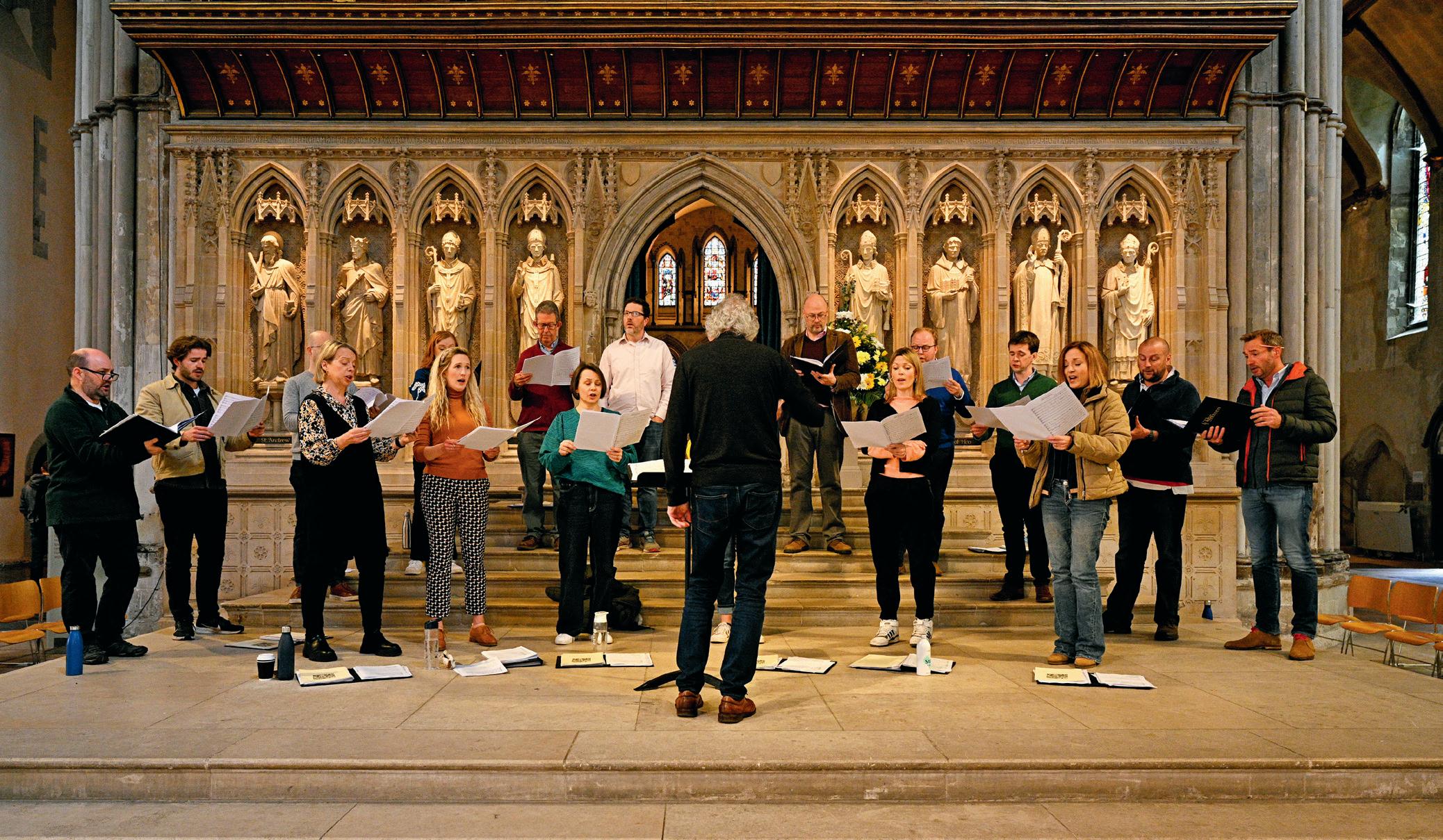

New scores include a rewarding Requiem to discover, new suggestions for weddings, music to mark Jane Austen’s 250th anniversary, and madrigals for spring
By RUPERT GOUGH
The most significant new score to drop on my doormat since Christmas was Kerensa Briggs’s Requiem (SATB (div), mezzo-sop & org; Boosey & Hawkes). First performed by the BBC Singers in 2022, it is now published and there is a fine recording by Kerensa’s alma mater: King’s College, London (Delphian Records). It is hard for any composer to write a Requiem Mass which draws on the plainsong Missa pro defunctis without inviting comparison to Duruflé. Kerensa’s harmonic leanings are certainly towards France (hardly surprising following a childhood growing up in the precincts of Gloucester Cathedral surrounded by her father’s passion for Pierre Cochereau) – however, here the comparison stops. While the sustaining accompaniment is often infused with Gallic colours, the treatment of chant is rather different; leaving the plainsong feeling firmly rooted in history rather than necessarily fully transformed into a modern idiom. Much of the writing steers away from literal plainsong quotation into a freer essence of chant, including intoned sections of text in the opening and closing movements set in the manner of a fauxbourdon – leaving the listener feeling drawn into a sung ritual. There is everything you may want in a good liturgical setting of the Requiem: a rippling Sanctus, rich eight-part textures in the Agnus Dei, and an In Paradisum that reaches for the heavens. There is only one small portion of English text (‘I heard a voice from heaven’) which sits alongside the Lux Aeterna in a strikingly beautiful, if short, movement. Overall, I do miss a little of the blaze and drama that we might expect from ‘Dies illa, dies iræ’ or the climax of the Sanctus. That
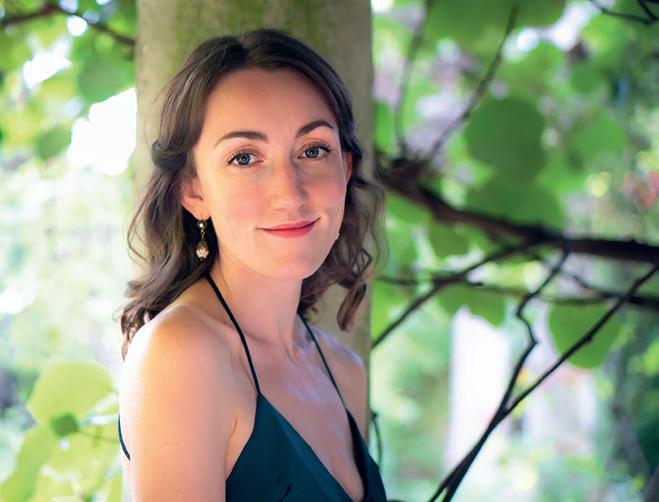
aside, Briggs’ setting is truly a welcome addition to the Requiem genre and ideal for both concert or liturgical use. Only one soloist is required but they do need to be a really good mezzo-soprano as the solo voice binds the whole together. There is plenty for choirs to enjoy by learning this piece, without it being particularly demanding, and Kerensa’s confident and highly effective writing is to be whole-heartedly commended.
If anybody is thinking of marking the 250th anniversary of the birth of Jane Austen this year, then do consider Three Prayers of Jane Austen (SATB unacc; Encore). Austen’s father was an Anglican clergyman and family prayers were always said in the evening. Jane Austen’s three surviving prayers were originally intended to lead into the Lord’s Prayer. Here, the texts are abridged making these motets a good length for an Introit or to conclude the Intersessions. The simplicity and sincerity of Austen’s words are reflected well in these uncomplicated settings by Charlotte Baskerville, Katharine Parton and Joy Williams.
At a time of year when many couples are planning wedding ceremonies and church musicians are asked for musical suggestions, I was pleased to discover
We are Married (SATB (div); Stainer & Bell) by Lille Harris. The words are adapted from letters exchanged between Robert Browning and Elizabeth Barrett – two renowned poets expressing true love with beautiful eloquence. Following a wordless, dreamy refrain, the passion and intimacy of the text comes across well in this short anthem which is quite simple and certainly effective. It only strays slightly from four parts, and only in the upper voices.
With spring in full swing, now is a good time to think about madrigals. In the UK the fashion for secular choral song has sadly waned since the days of Vaughan Williams and Holst so I was heartened to see a set of wonderful new madrigals. Three Madrigals (SATB (div); Stainer & Bell) were composed by Will Harmer for the National Youth Choir Fellowship Ensemble 2023. They fall into that category of choral repertoire that is particularly good for competition singing (like Vaughan Williams’ Shakespeare Songs) –technically demanding and yet fun both to sing and listen to. Spring in all her glory has a jaunty modality that nods towards the Tudor madrigal school. Sweet eyes has a jazzy lilt and is richer in harmony to accompany the strains of the lamenting lover. The final madrigal Sing we at pleasure is a lively 7/8 dance with plenty of ‘fa la la’s (and hand clapping) for good measure. All is skilfully crafted by a young singer who clearly understands the voice with nothing stepping out of a comfortable vocal range.
RUPERT GOUGH
Rupert Gough is director of choral music and college organist at Royal Holloway, as well as organist and director of music at Saint Bartholomew the Great. He is also a published composer, arranger and editor.

Cloister
Will Fraser
New Generation Publishing
ISBN 9781835635278
available through Fugue State Films https://fuguestatefilms.co.uk/product/ cloister/
Will Fraser’s name may be known to some readers of this magazine through his wonderful films about subjects such as Bach, Vierne, Cavaillé-Coll and The English Organ. He is also fascinated by America and his films about the country’s culture include one about Blues music. In this debut novel he brings together these two strands of interest to tell the story of Matthew Marcan, a cathedral organist who returns from a job in Germany to his home city of Bristol, hoping to succeed his great mentor and friend Richard Galvin, who has recently died, as the cathedral organist. But he finds that an informal appointment has already been made and his only option is to take on the role of assistant to Geraint Perryman, a gifted but unstable character who lurches on and off the wagon and has a casual and cynical attitude to cathedral music-making that distresses the idealistic Matthew. While wrestling with the dilemma of how to do his job conscientiously in this environment Matthew meets and falls in love with Blues singer Chloe,
and even manages to find a role for her in an innovative cathedral service that impresses both Geraint and the (American) Dean, who is supportive of his musicians but also sees the need for cathedral worship to connect with the wider community.
So far, so Joanna Trollope … and Cloister does have a lot of similarities to The Choir, especially as it is set in the early 1990s, not in the present. (It is quite strange as a reader to return to a world without mobile phones.) But this is a much, much darker story. It turns out that Chloe hasn’t managed to shake off a sinister figure from her past …
Fraser takes a few liberties with the internal geography of Bristol Cathedral and with the cityscape, not to mention with safeguarding procedures and employment law, even allowing for the more relaxed attitudes of 30 years ago. His love for the architecture, music and language
of the Anglican church shine through and he writes very engagingly about the techniques of not only playing but organ-building – so much so that I don’t think the amount of space devoted to the topic would be a barrier to non church musicians enjoying the book.
The principal characters in the cathedral’s psycho-drama are complex and well drawn, and sadly I think many of their bitter conflicts will be recognisable.
Less successful for me is the Gothic parallel story of Chloe and her nemesis; and the cover endorsement comparing Fraser to Colin Dexter and John Le Carré is misleading, for this is neither a tidy police procedural nor a spy thriller. But I found lots to relish in this imaginary vision of cathedral life in a city that I haven’t often seen portrayed in fiction.
CLARE STEVENS

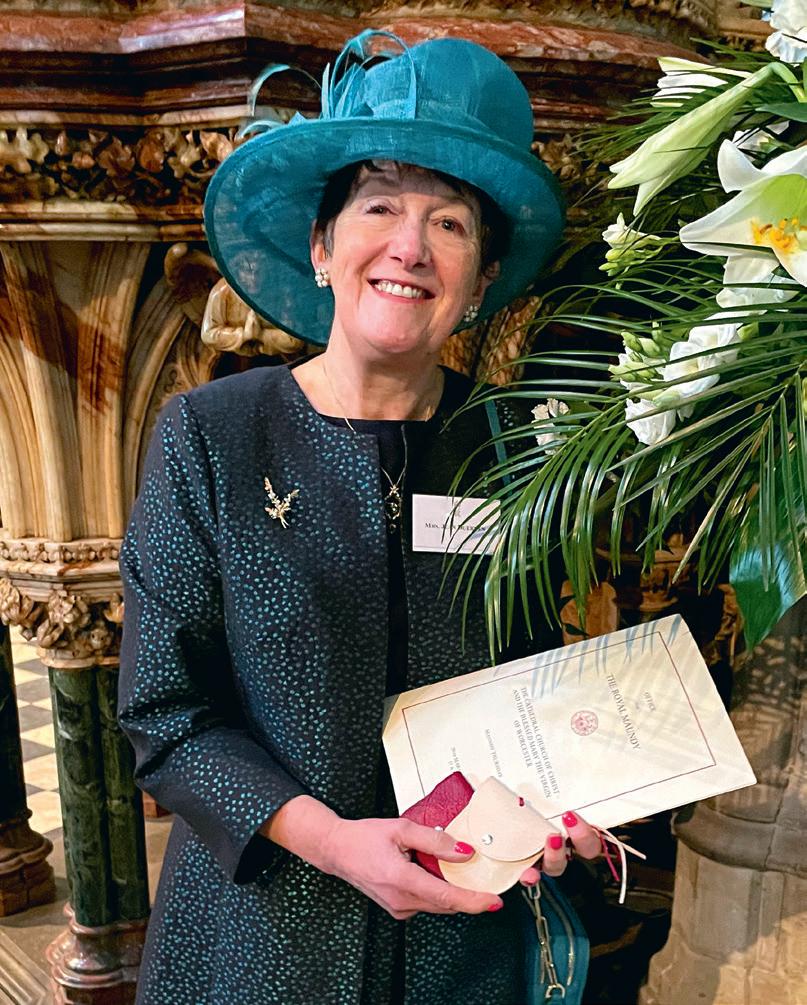
How did you get involved with cathedral music?
My husband Jeremy and I had a city break to Dublin. Coming out of the Dublinia exhibition in Christ Church Cathedral we heard the choir singing Evensong and joined the service. It was a really emotional experience and when we got home we realised that we could hear wonderful music like that just nine miles up the road at Blackburn Cathedral. That was 24 years ago, and we’ve been members of the Blackburn congregation ever since.
I understand you help out in Blackburn Diocese in addition to your role at Cathedral Music Trust? Yes, I administer the four-yearly diocesan conferences and have organised events such as Festivals of Prayer, of Faith and of Baptism. My career before that was with the NHS, specifically as a midwife; for the last ten years of my NHS career I was the Local Supervising Authority Midwifery Officer for Yorkshire and Northern Lincolnshire.
How long have you been involved with CMT? What made you join and how did your membership of the Events Working Group come about?
Jeremy and I had been members of the Friends of Cathedral Music for quite a long time and a few years ago
JEAN DUERDEN
‘It was a really emotional experience and when we got home we realised that we could hear wonderful music like that just nine miles up the road at Blackburn Cathedral’
Interview by CLARE STEVENS
he took on the role of diocesan representative for Blackburn, now known as Local Ambassador. I’ve always loved doing organisational jobs and managing spreadsheets and when Rosemary Downey stepped down as National Organiser, I thought it was something I would enjoy. It’s close to Jeremy’s heart as well and it’s something we can do together now that he is retired. He’s my bag carrier, chauffeur and cook!
Can you explain the process of organising a CMT National Gathering?
It starts a long time in advance, for example I’m now working on the 2027 schedules. We’ve changed from three national gatherings a year to two, but we are trying to combine visits to several foundations in one weekend, so we’ve got Newcastle, Durham and Hexham Abbey in May, and we will be doing Canterbury and Rochester together in October. Some cathedrals are very keen for us to visit them, but we have to try to do it in rotation, so there are now 15 or 20 years between each National Gathering visit.
The initial approach is always made through the Director of Music, but these days we are usually passed on fairly quickly to the marketing department, especially in the big foundations, with so many commercial events to work around.
What are the ingredients of a successful National Gathering?
An eclectic programme is important but first-class choral and organ music is the main thing. Meeting the musicians and clergy, getting to sit in on rehearsals, or seeing particular cathedral treasures or places not normally open to the public is very much part of the attraction of these weekends. We usually lay on an activity not related to cathedral music so our Newcastle gathering will include a concert at The Glasshouse International Centre for Music, Gateshead. Not everyone does everything - some people just like to put another stamp on their Cathedral Passport!
What do you personally get out of helping to organise these events? I genuinely relish the administrative challenge, but I always enjoy the meeting and greeting too.
How can other people with an interest in cathedral music get involved?
The gatherings are always open to non-members of the Trust and we try to make sure we chat with newcomers and encourage them to join. We are always looking for new Local Ambassadors as there are quite a few cathedrals that don’t yet have them.

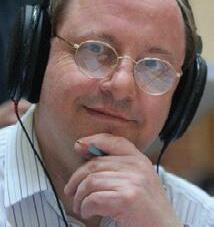
Regent Records is delighted to announce that their founder and producer, Gar y Cole, has been awarded the medal of the Royal College of Organists in recognition of his distinguished achievement in organ and choral recording

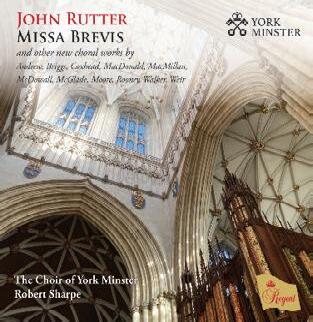

JOHN RUTTER: MISSA BREVIS and other new choral works by living composers
The Choir of York Minster directed by Robert Sharpe
REGCD576
This latest disc from the acclaimed choir of York Minster has at its heart the new Missa Brevis written by John Rutter for the memorial ser vice of Richard Shephard, a composer with a long association with York and its Minster This appears alongside new works by Kerr y Andrew, Kerensa Briggs, Elizabeth and Thomas Coxhead, Sarah MacDonald, James MacMillan, Cecilia McDowall, Becky McGlade, Philip Moore, Annabel Rooney, Lucy Walker, and Judith Weir ‘[the] choir sounds confident and vigorous in the Minster’s extravagant acoustic , full of lively resonance in this recording ’ ★★★★ BBC Music Magazine April 2025 ‘quite simply, a triumph ’ Yorkshire Times March 2025
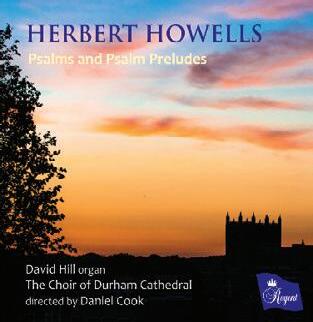

David Hill (organ)
The Choir of Durham Cathedral directed by Daniel Cook
REGCD586
The inspiring poetr y of the Psalms was a powerful creative stimulus to the composer Herbert Howells (1892–1983), throughout his life This recording is a unique project combining the six Psalm Preludes Howells wrote for solo organ, preceded by the six Psalms which inspired them The Psalms are sung to ten chants by Howells, several of which are receiving their first recording The Psalm Preludes are played on the organ of Durham Cathedral by the renowned organist David Hill, who has a long-standing association with Durham Cathedral, and the Psalms are sung by the Choir of Durham Cathedral, in their first recording on the Regent label, under their director, Daniel Cook
Critical recognition for David Hill’s previous solo organ recordings on Regent: REGCD539
‘ gloriously performed (and recorded) on the resplendent-sounding organ of Peterborough Cathedral Gramophone Editor’s Choice
I can t imagine better performances American Record Guide Critics’ Choice a fine recording, not to be missed The American Organist REGCD163
This is a sumptuous recital by David Hill ever y last ounce of tonal subtlety is wrung from the 79-stop Willis/Harrison organ ’ BBC Radio 3 CD Review
REGENT RECORDS, PO Box 528,Wolverhampton, WV3 9YW
01902 424377 www regentrecords com (with secure online ordering)
Retail distribution by RSK Entertainment Ltd, Tel: 01488 608900, info@rskentertainment co uk Available in the USA from the Organ Historical Society www ohscatalog org Scan QR code to sign up to our mailing list
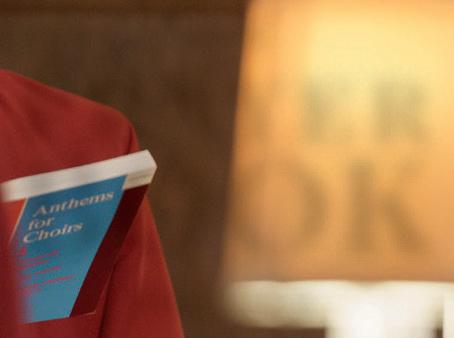

For more than 50 years the Prayer Book Society has been working to keep the Book of Common Prayer at the heart of the Church of England.
New generations are discovering the beauty, depth and majesty of the BCP, many through Cathedral services.
In addition to promoting Prayer Book services across the country, the Society runs many national and local events.
Join us and help keep this wonderful tradition thriving in our churches. www.pbs.org.uk













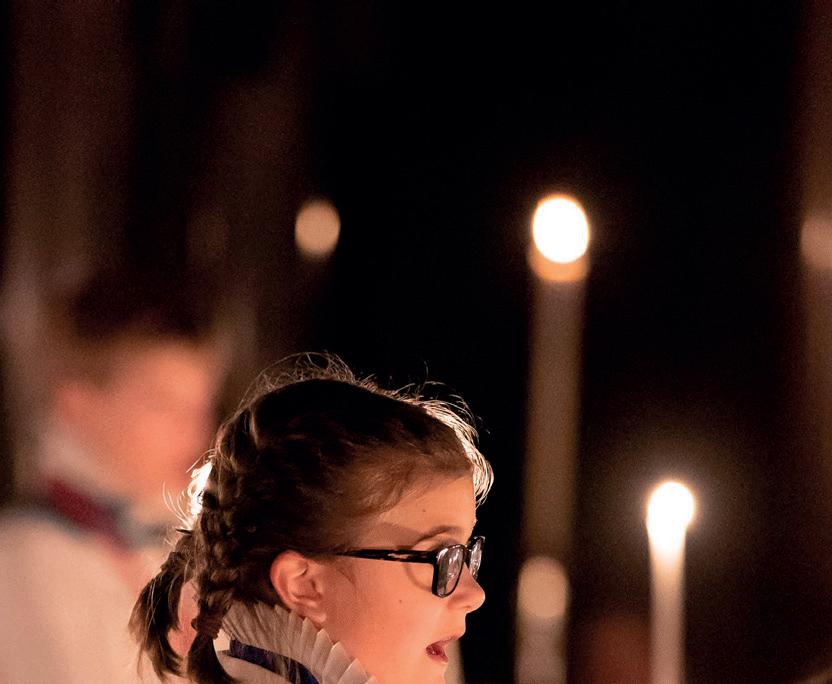
www.cathedralmusictrust.org.uk/legacies
